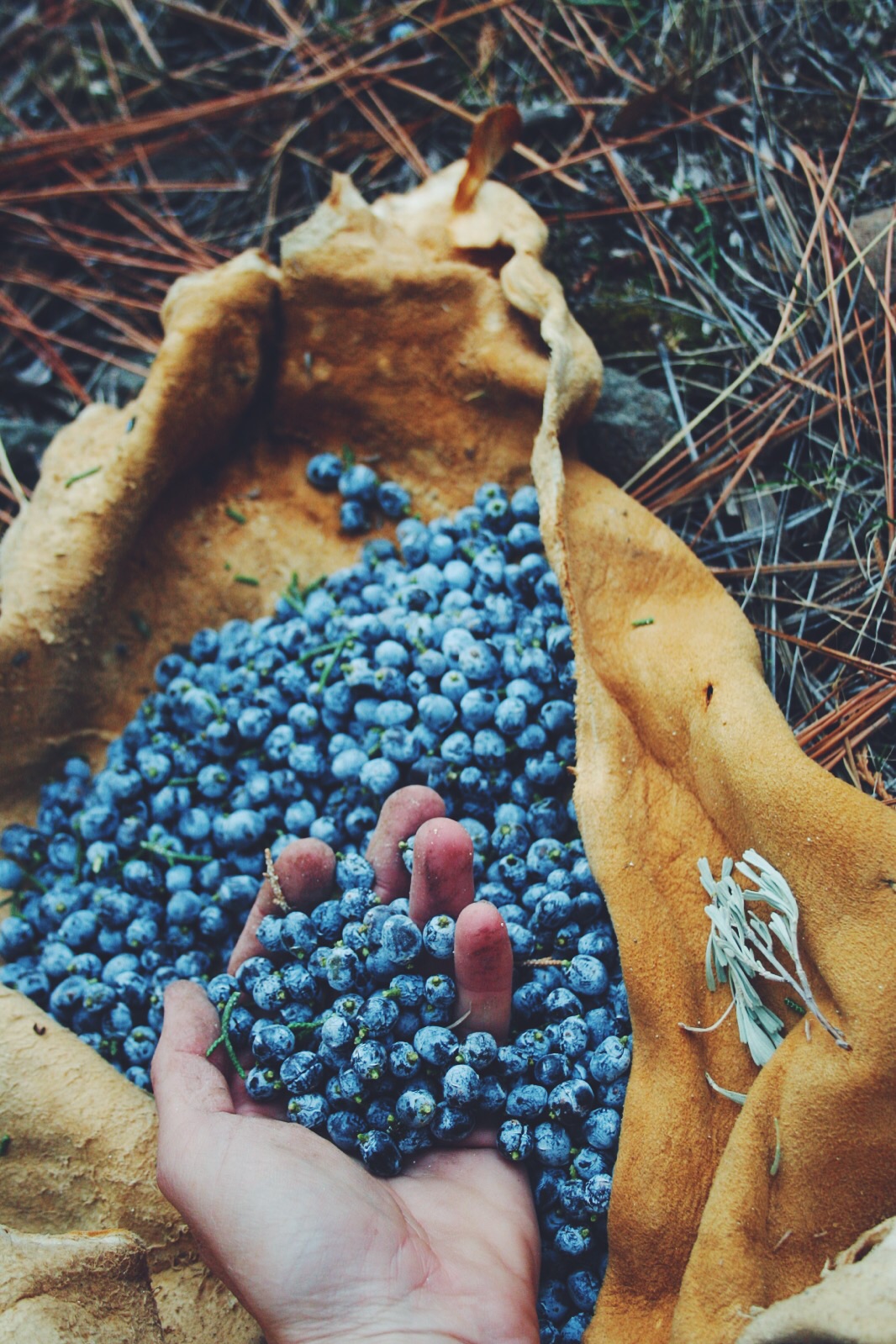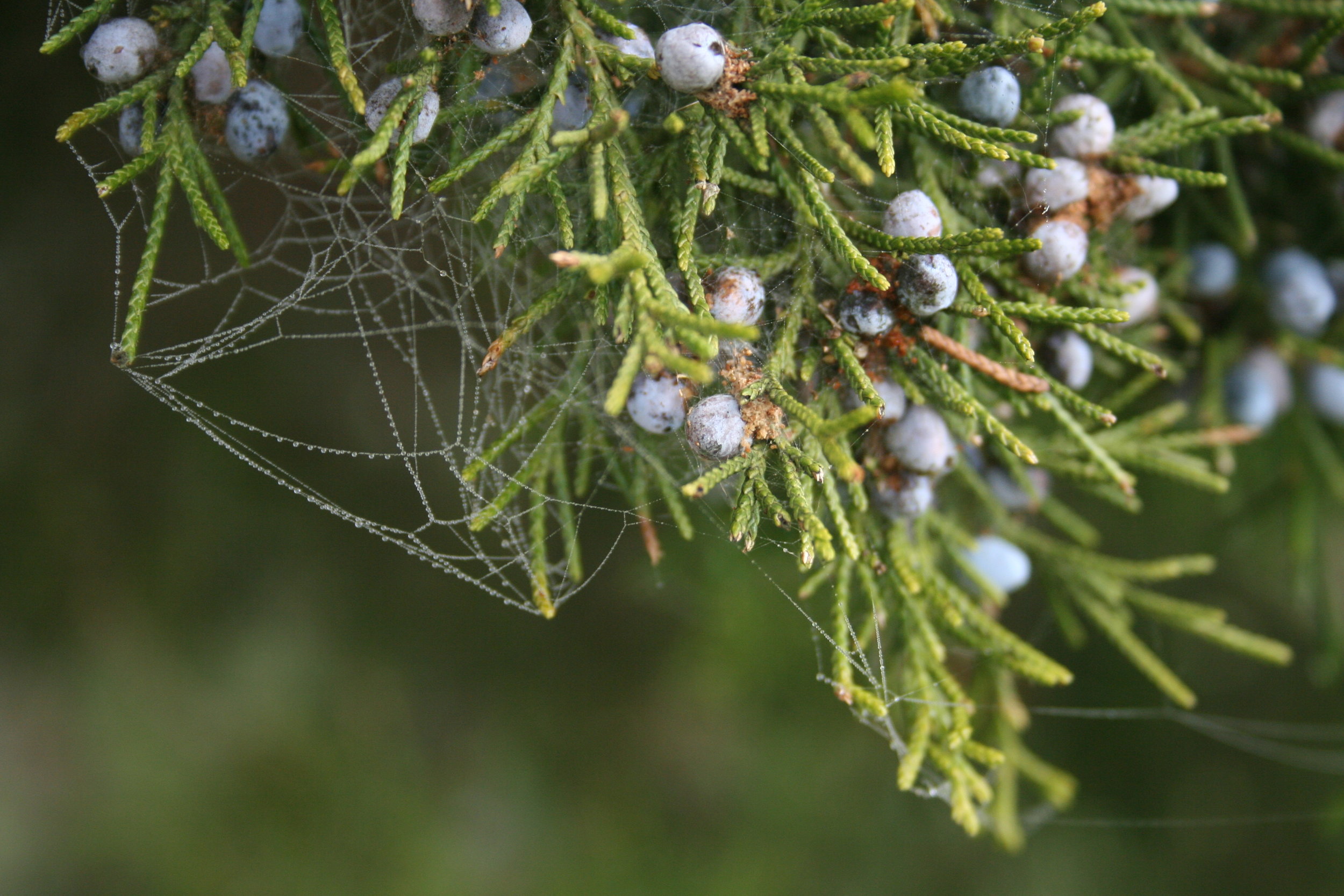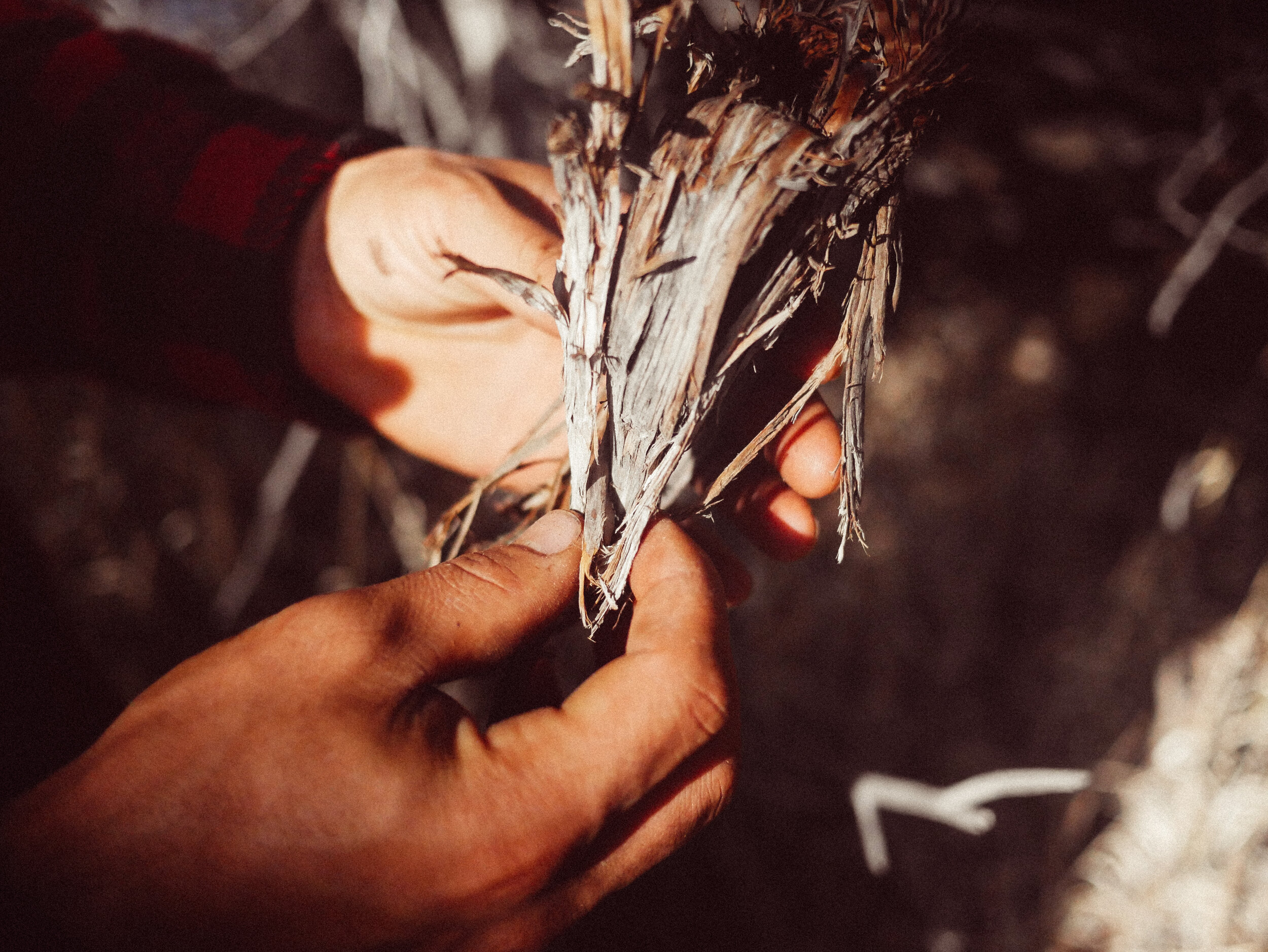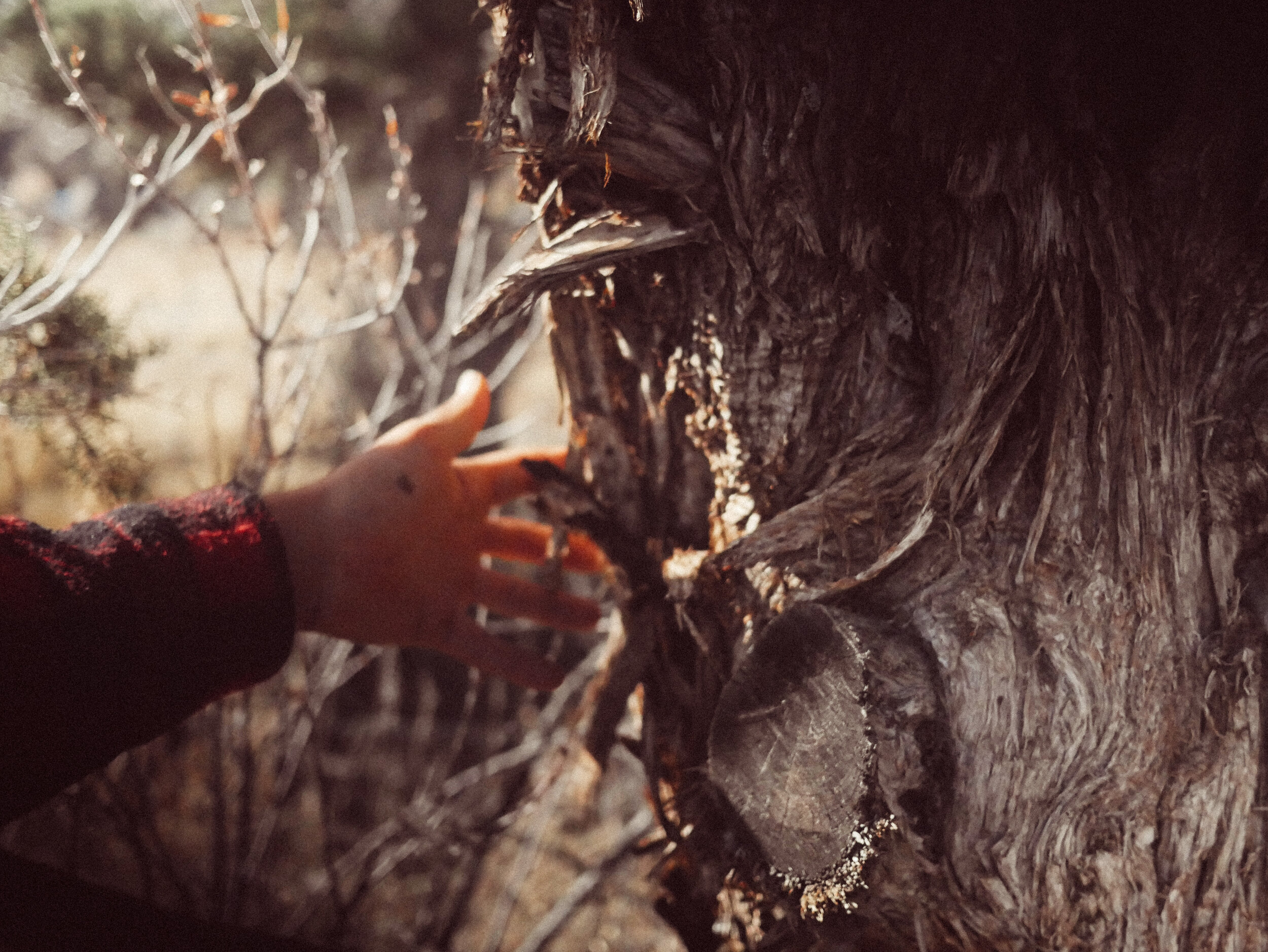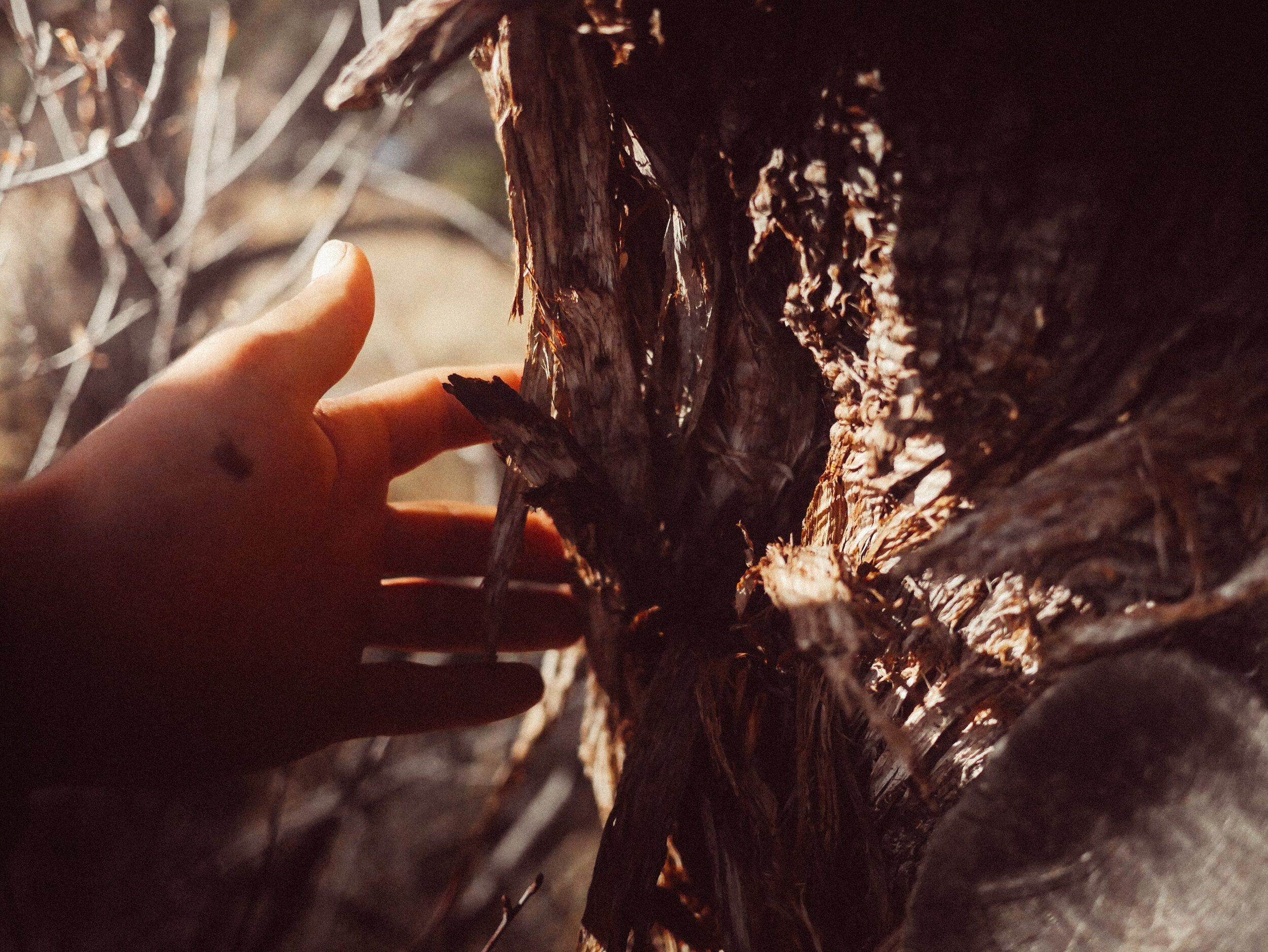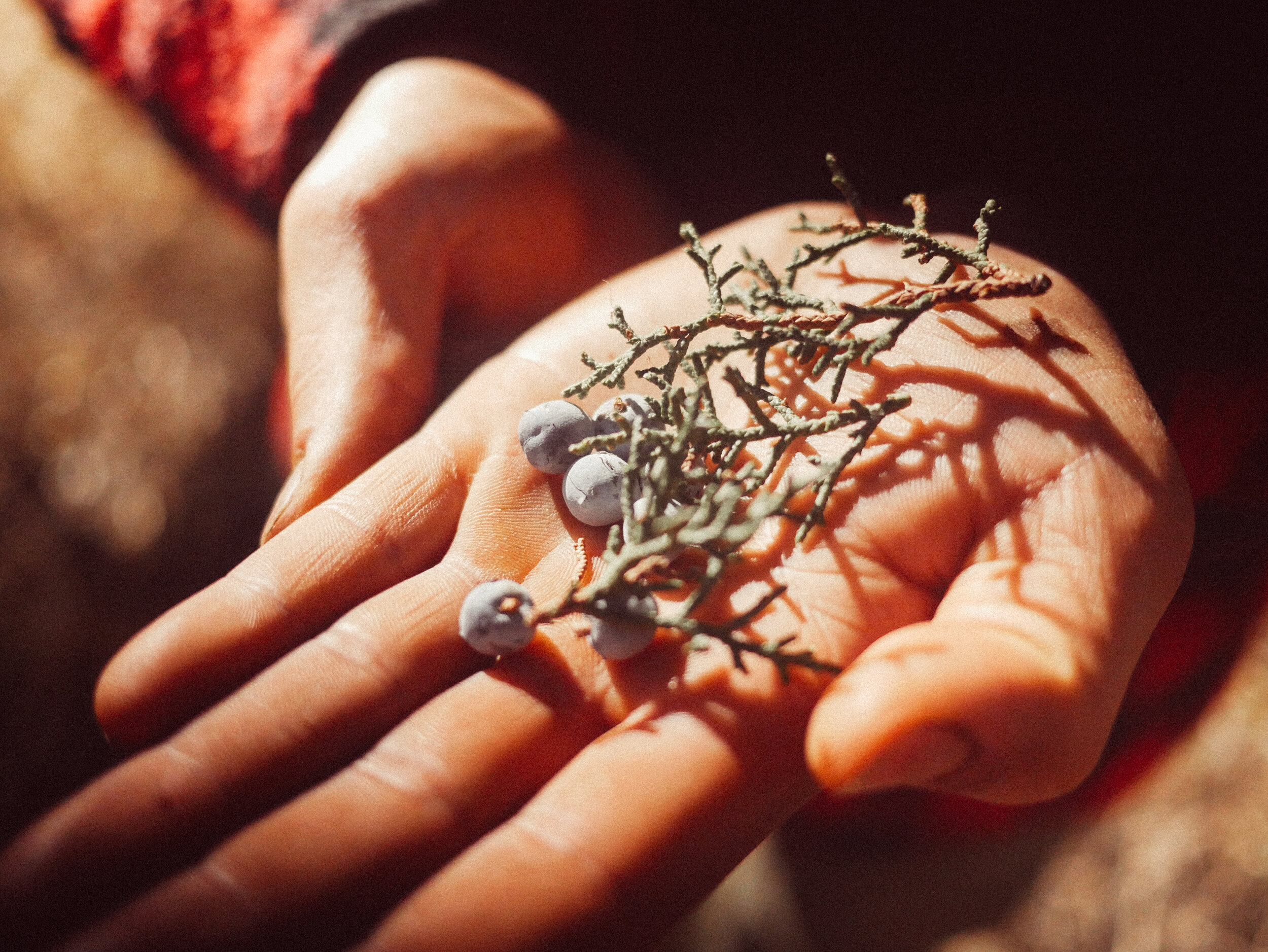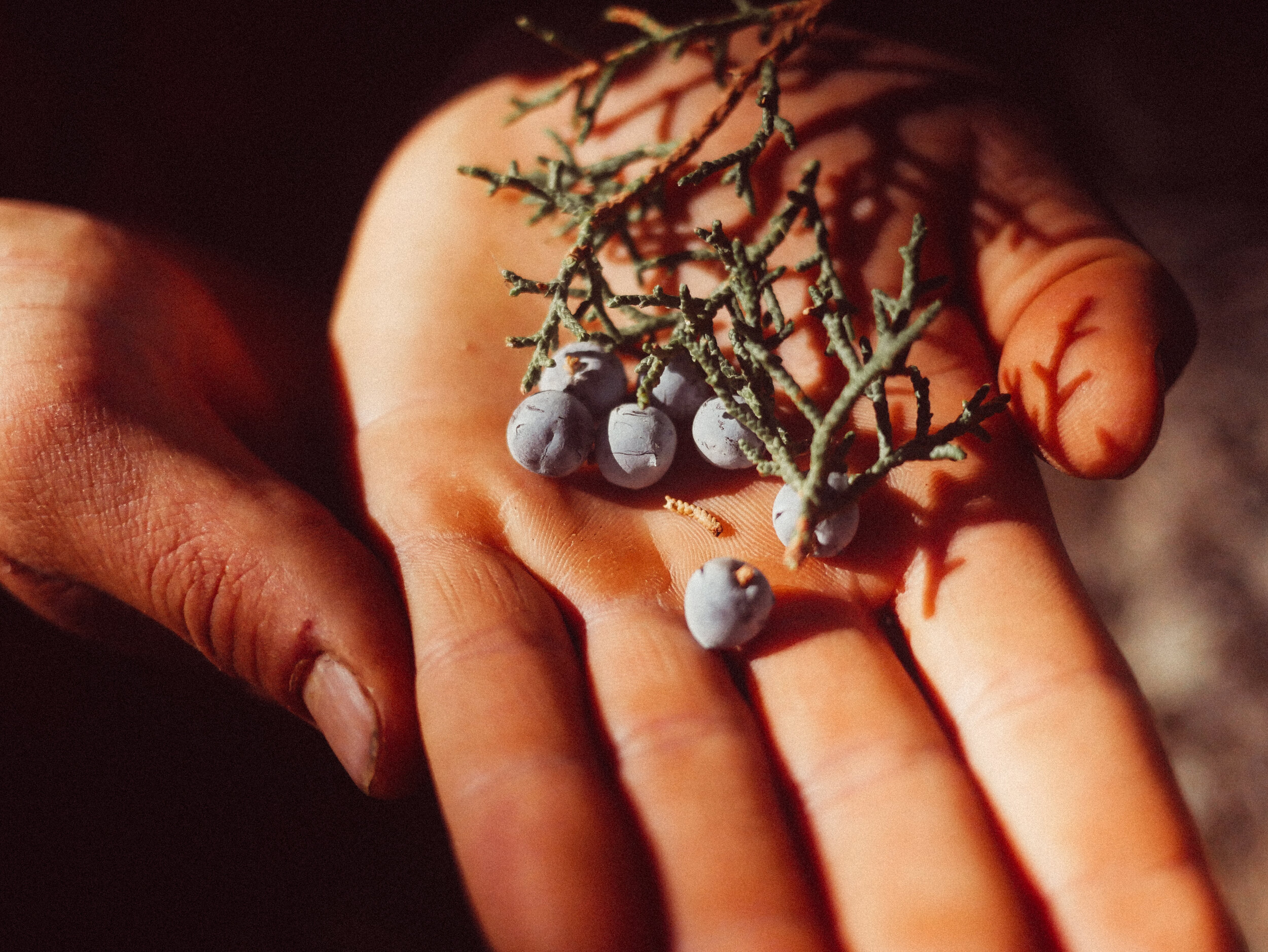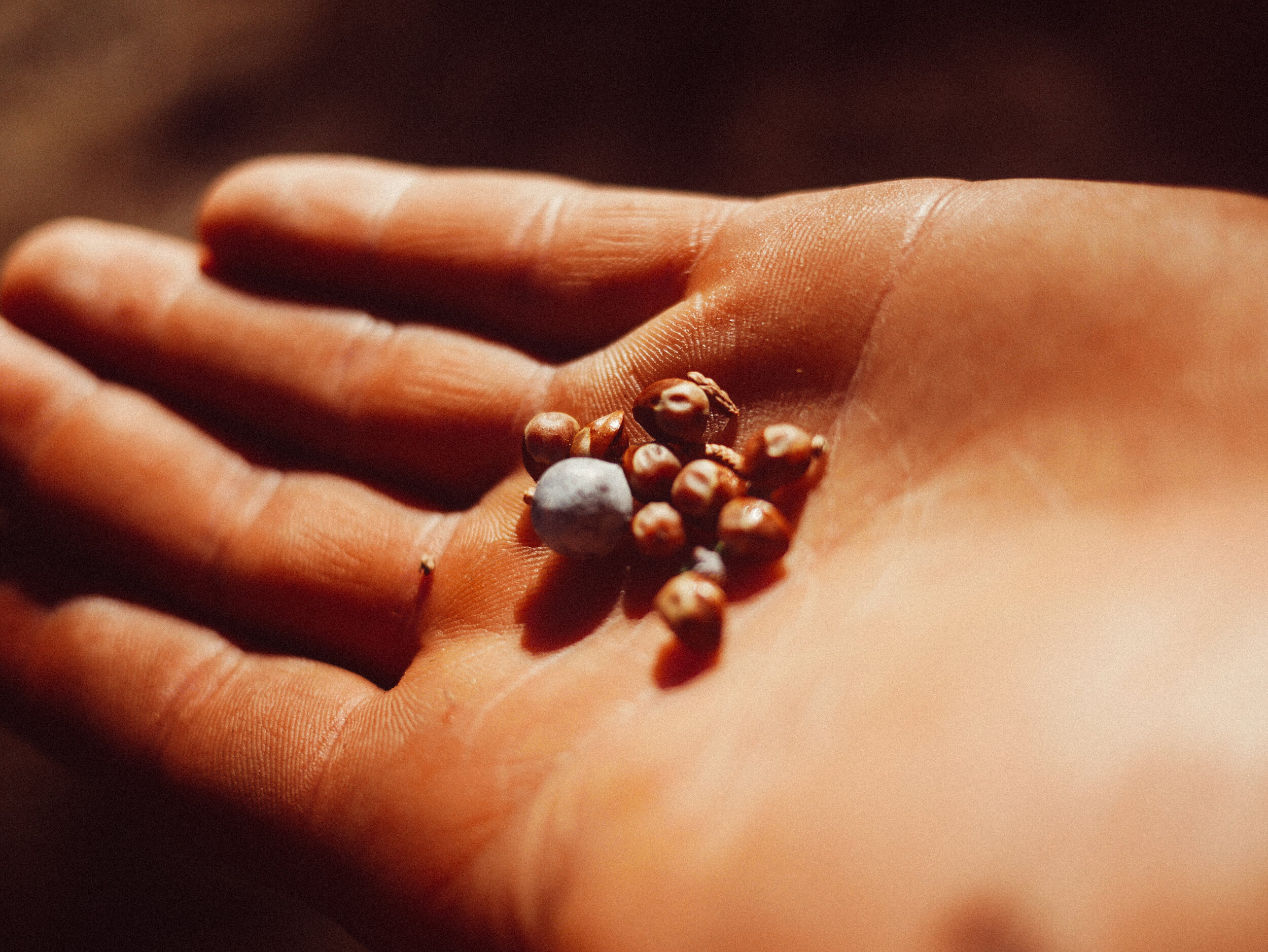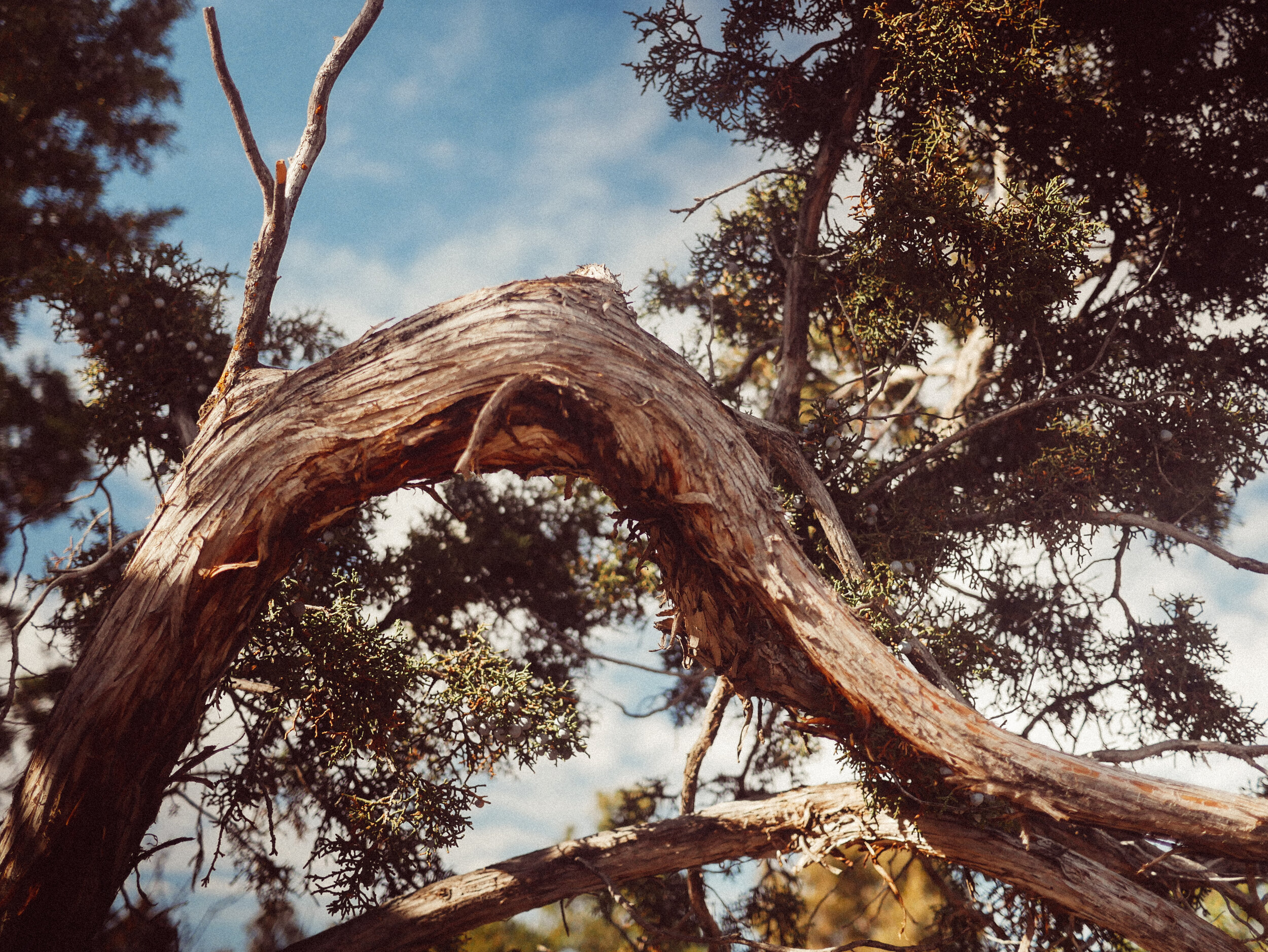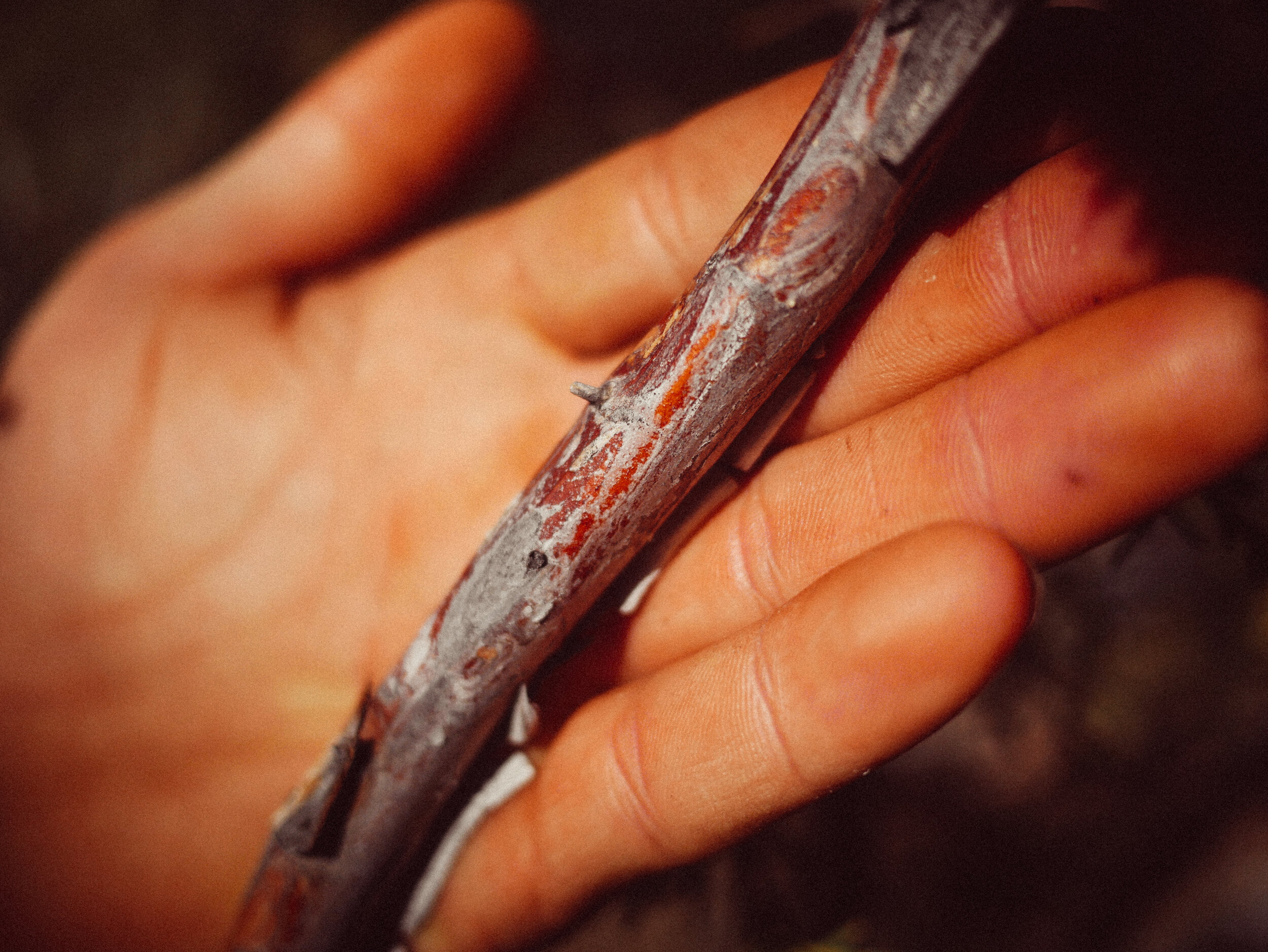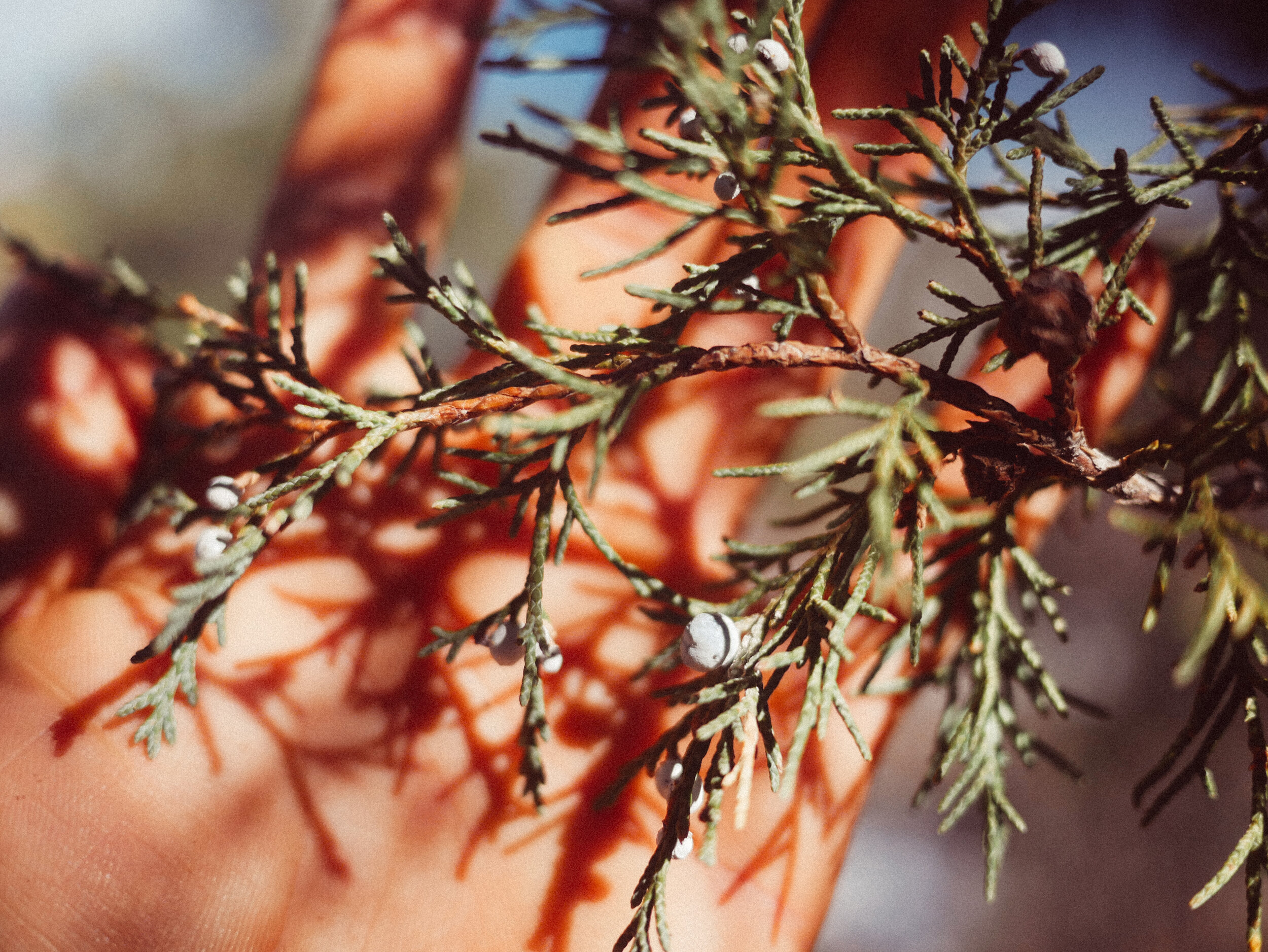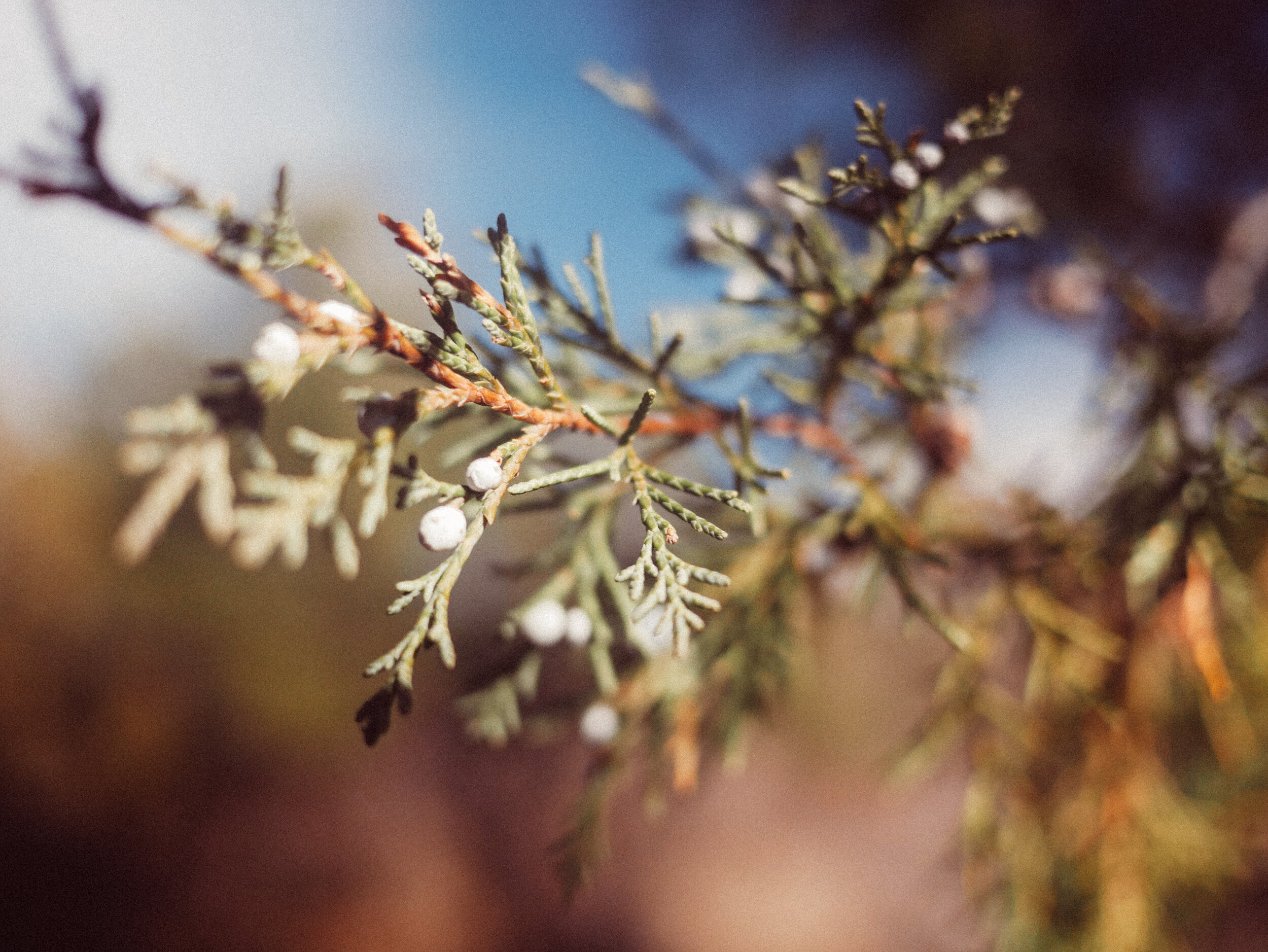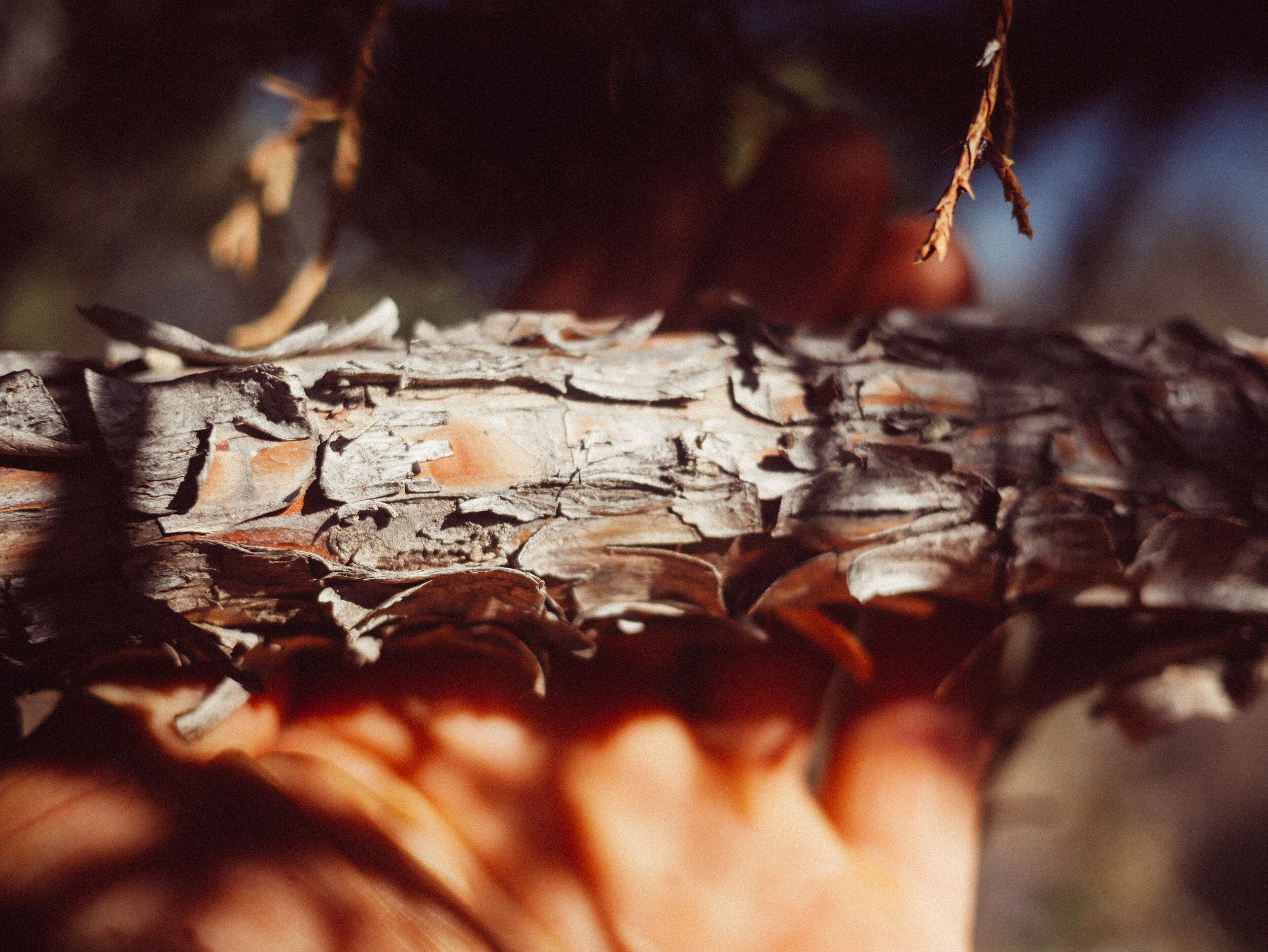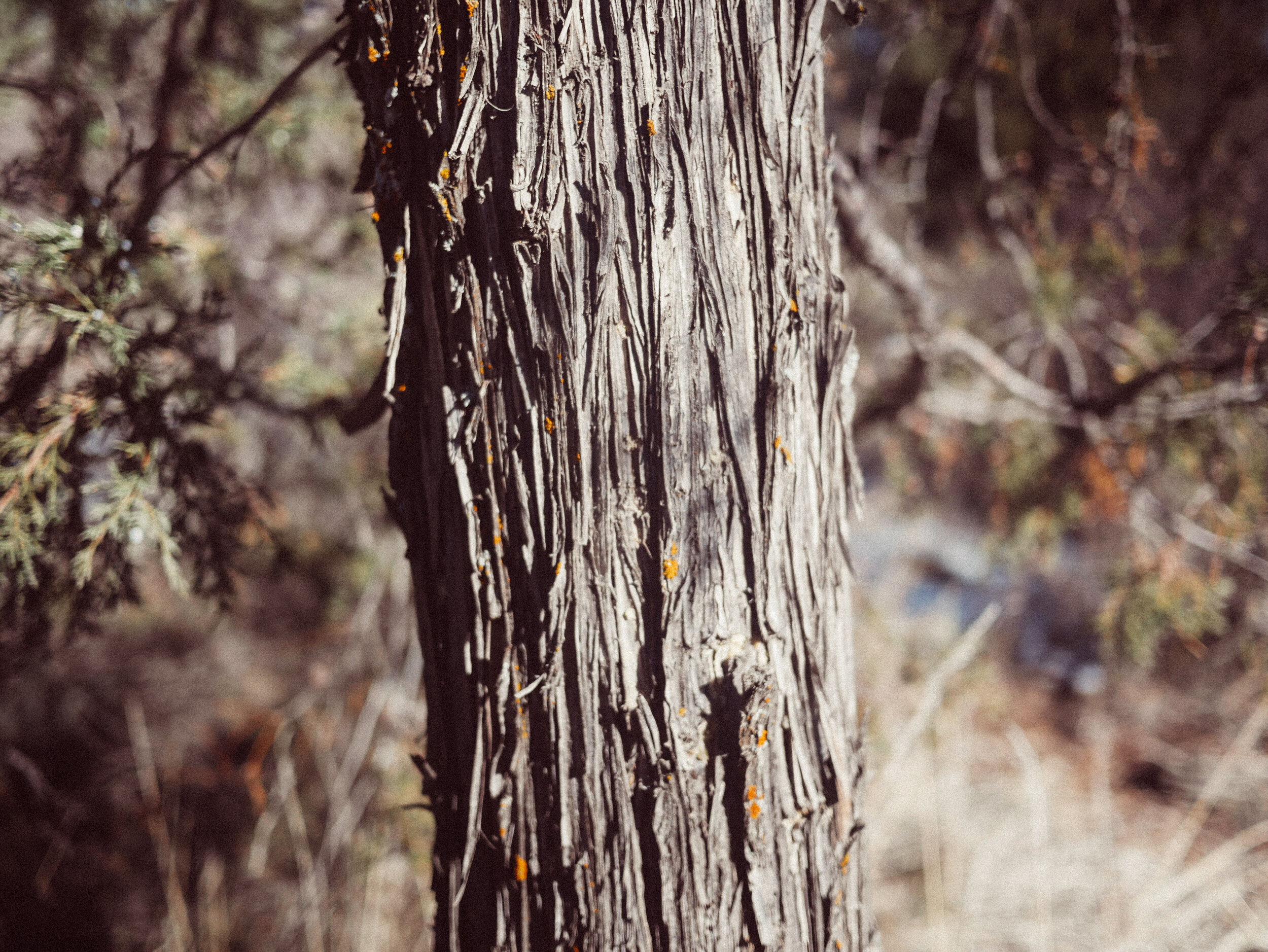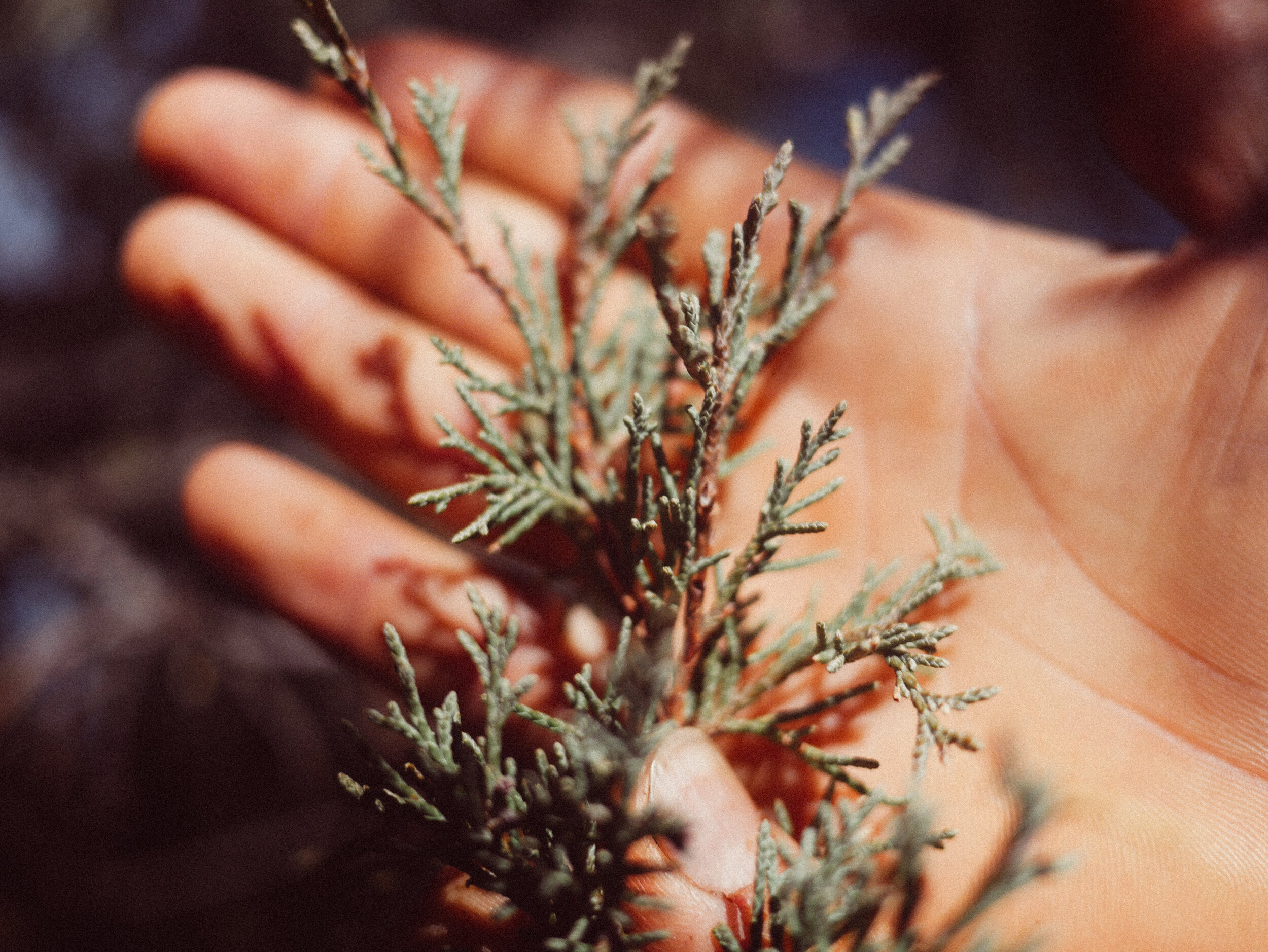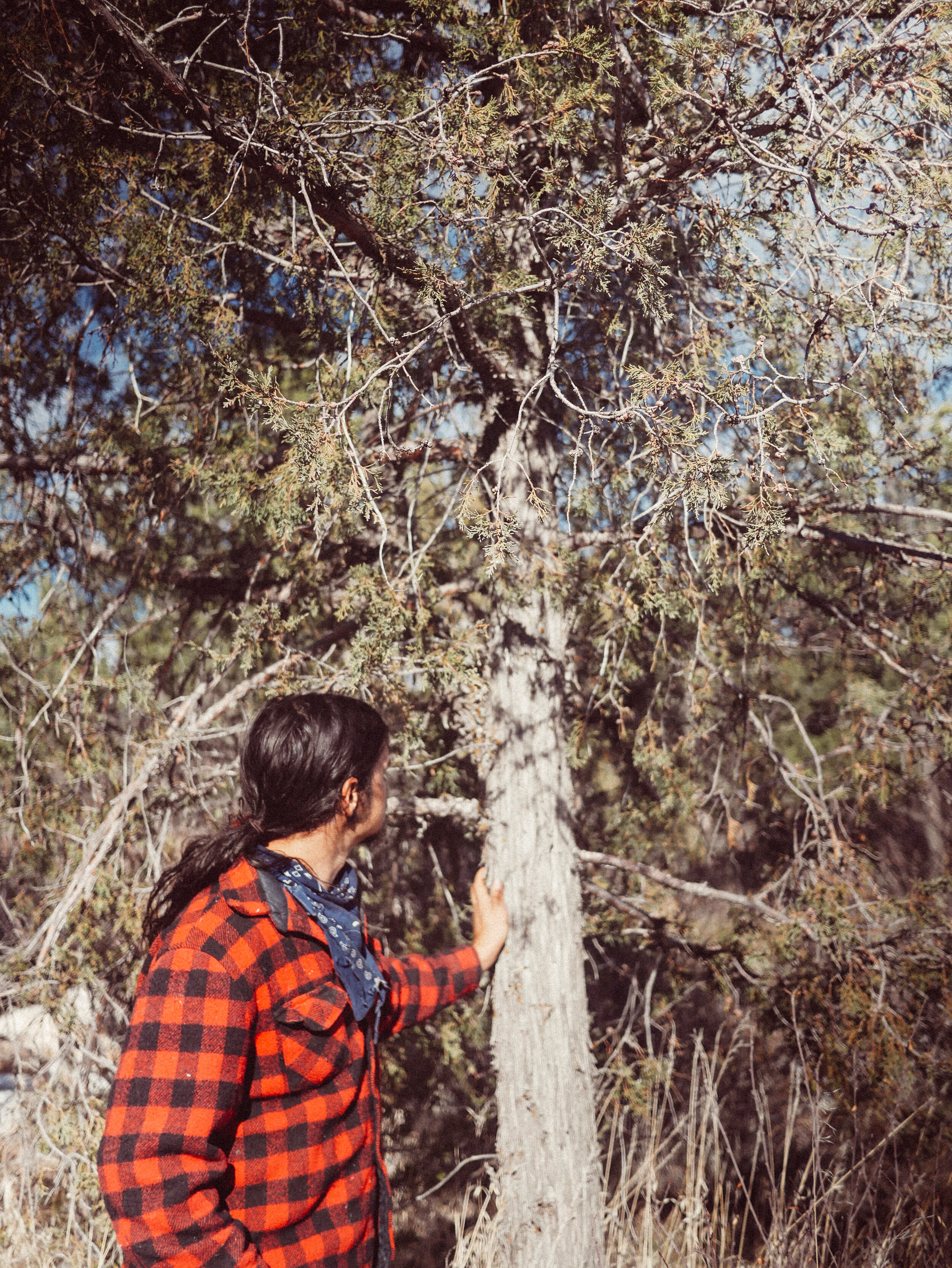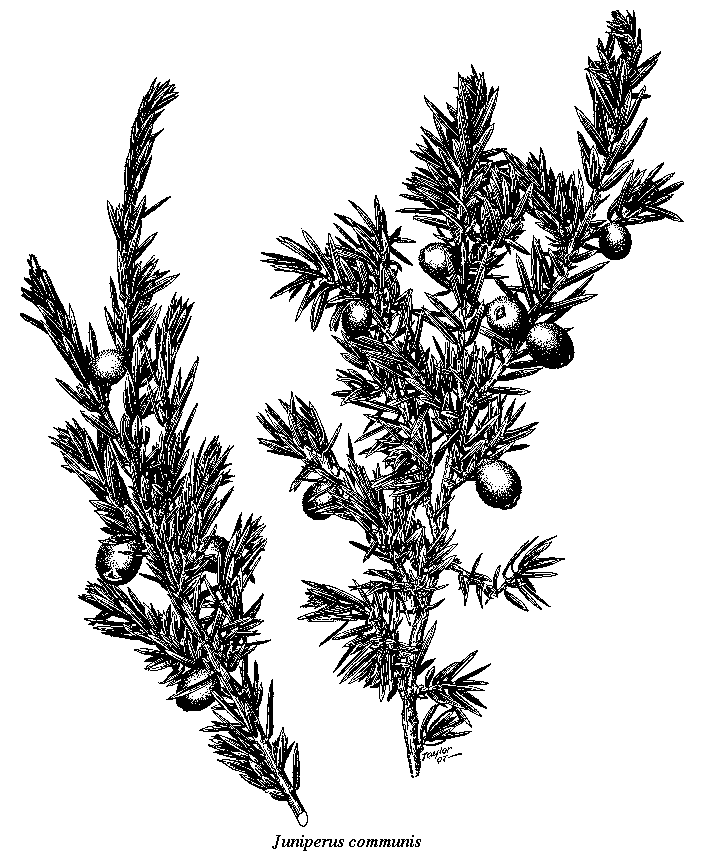Order of Contents:
story
Cypress family
Juniperus genus
Juniperus virginiana / Eastern Red Cedar
video shot by Kym Slade briefly showing Eastern Red Cedar
Juniperus communis / Common Juniper
Juniperus utahensis / Utah Juniper
Juniper Medicine
A note on Juniper Magic and the lens of settler-colonialism
Juniper Medicine: Europe/Scandinavia, Gin
Drinks
Juniper Medicine: Asia/Russia/Japan
Juniper Medicine: Mediterranean/Middle East
Juniper Medicine: Canada/Northlands/Turtle Island
Works Cited/Resources
(originally published in 2018)
(updated with new information Jan 2021)
(updated with new information December 2022)
1.
Yesterday, I was working in my old herb garden in my hometown, in southern Virginia. There’s something deeply relieving about revisiting a place that you’ve cultivated in some way. Tending it and exchanging whatever energy through time you’ve tied yourself to each other through. There’s something to that, you know? Places are like that with me. Plants are like that with me, and gardens especially. All the kinds of gardens that can exist. Whether it was the Osha (Ligusticum porteri) seed I sprinkled in the soil cracks in the Wallowas, the Thyme (Thymus vulgaris) I planted at Dancing Springs in Barnardsville, the Calamus (Acorus calamus) at Juliet’s or in my parents’ creek sneakily buried in mud and grasses, the Monarda (Monarda spp.) and Elecampane (Inula helenium) I buried long ago in the soils of my dad’s little spot in the world. It reminds me that I feel most whole while gardening, while taking care of plants, while watching them, and feeling an utter since of joy and heart-openness to plants that I only occasionally feel with humans. Or rather; plants allow me to step into the heart open realm a little more with humans.
My friend Kym and I processed Ginger (Zingiber officinale) with my dad from his greenhouse crop, tended all summer, making sure to keep the greenhouse doors open for the breeze to flow through. We dug Elecampane root, from plants I have put in the ground years ago but never harvested. I think they will enjoy a little ruffling, a little space to spread out- as I divided some of the roots and replanted the small ones elsewhere.
By the Juniper hedgerow. Photo by Kym Slade. October 2018.
Whenever I hang out in that herb garden, I find myself often drawn to long staring into the wild hedgerow that follows a metal fence, all of it at the top of the property, on a little knoll. This knoll means I can hear things way in the distance, unfortunately the interstate sometimes, other times it is the donkey next door, hunting dogs or coyotes way out there. The hedgerow consists almost solely of Eastern Red Cedar or Juniperus virginiana. This is not an abnormal hedgerow to have in these parts of the world, especially on these high and dry sites. My papa has them at his farm in the field, along the fence line, along the pond. Pretty much everything at his farm— the old fence posts that still stand 75 years later, some of the farm equipment that back in the day they handmade and even black-smithed the iron parts- are made of this Cedar or Oak. The fence line might have Cedar posts, with live Cedar trees growing next to the posts wrapped in barbed wire and painted white. Sometimes they are rough hewn, other times they are made nicely.
Cypress plant family (Cupressaceae)
2. So, the Eastern Red Cedar I mention from my dad and papa’s farm, as well as other Juniperus species, are all in the Cypress plant family, or called the Cupressaceae. When I chat with my horticulturist dad about his ornamentals in this family, he refers to them as ‘Cupresses.’ Alongside Junipers, a few other members of this family that some folks might recognize include the grandiose Redwoods (Sequoia sempervirens) which mainly grow in coastal California, Incense Cedars which mainly grow in the Sierras of California with some range in northern California coastal and southern Oregon (Calocedrus decurrens), Western Red Cedar which is primarily found in the Pacific Northwest and northern California along the coast into B.C.(Thuja plicata), Yellow Cedar from southern Oregon up to Alaska (Cupressus nootkatensis) Cypress (Taxodium distichum), and Sequoia (Sequoiadendron giganteum) which is mainly located in the southern California Sierras range.
Cypress family plants are conifers, a broad general grouping characterized by their cone-bearing seed dispersing techniques. Not all Ccnifers are in the Cypress family though, as worldwide there are several plant families of cone-bearing species. Plants in the Cypress family, including Juniper species are considered gymnosperms, which is the name for the ‘naked seed’ dispersal techniques of older more ancient plant families that include all Conifers as well as trees like Gingko. Most plants in this family are evergreen, but a few are not. Their seed cones vary in style and structure. Some plants in this family have needle-like leaves, others scale-like, and some start off needle-like and move to scale-like in age. Plants in this family can be found pretty much all over the world, from some of the coldest or highest locations, to some of the lowest and warmest. They can be found in moist or dry locations, and often they are specialized to that ecology and location and can be rare where found. You’ve got Junipers up on high mountain peaks in Nevada, and Swamp Cypresses in Florida down in the lowlands- both genus’ are in this plant family.
William L. Farr, CC BY-SA 4.0 <https://creativecommons.org/licenses/by-sa/4.0>, via Wikimedia Commons - Bald Cypress, Texas
My dad talks about selling all kinds of different ‘Cypress’ varieties at our family nursery that ran from the 60’s until two years ago in the Piedmont region of southern Virginia, this included a mixed of hybrid species, cultivated species and straight up wild species of different trees and shrubs in this family. After talking to him this week about it, he named some things he sold and used in landscape plantings including ‘Leland’ Cypress Cupressus × leylandii (a Monterey and Yellow/Nootka Cypress (Cupressus nootkatensis) cross, popularly used among horticulturists to plant fast shade. It’s mainly infertile, with a few exceptions), ‘Swamp/Bald’ Cypress Taxodium distichum (this species is found in the wild mainly in the southeastern U.S. lowlands), and ‘Italian’ Cypress Cupressus sempervirens (native to the Mediterranean).
He sold Cedrus species like ‘Blue Atlas’ Cedar Cedrus atlantica, (native to northern Africa) and ’Deodora’ Cedar, Cedrus deodara (native to the Himalayas) which are NOT actually in the Cypress family but the Pine family. These are the species the ‘Cedar’ common name is likely based on. He used Thuja species and cultivars like Arborvitae, ‘Green Giant,’ and ‘Green Emerald.’ The Juniperus species he used were ‘Blue Pacific,’ ‘Blue Rug,’ ‘Nick’s Compacta,’ ‘Blue Lake pfitzer’ and a lot of other different ones he couldn’t remember. He also planted trees that are in the Chamaecyparis genus in the Cypress family. Though my dad and I have completely different interests in plants (though that is changing on his end)— he in cultivars and ‘pretty’ things, I in ecology, medicine, ethnobotany and history of plants— we can talk about this stuff and be on the same page, or at least hold conversation. I can prompt him with some good questions and he knows what I am talking about.
In California, there are endemic species of Cypress that grow on serpentine soils like Cupressus sargentii and Cupressus macnabiana. Of course there are tons more Cypress’ out there and so much more to say about the Cypress plant family.
The Chamaecyparis genus includes the small range of coastal Port Orford Cedar of the West coast of Oregon and northern California (Chamaecyparis lawsoniana) and Atlantic White Cedar (Chamaecyparis thyoides) on the East coast from Maine down the southern coasts and even is found on the shores of the Gulf of Mexico.
In addition to the culturally significant Western Red Cedar of the Pacific Northwest (Thuja plicata), another Thuja grows in New England, the Great Lakes region and into the interior of Canada (Thuja occidentalis).
It’s interesting to note how many endemic species there are in the Cypress family. McNab Cypress in California, I hung out with when I lived in Nevada City, CA, only grows on serpentine soils for the most part. Monterey Cypress is endemic to one area in central California, yet is demonized as ‘invasive’ because it grows so well as an ornamental worldwide, and even in the Bay area of California it is being ‘eradicated.’ Yellow Cedar in Canada and Alaska which hugs the temperate coast, famous for its soft and resilient fibers, only grows in that region. Arizona Cypress is only found in a small area in Mexico, southern Texas, New Mexico and Arizona. These are just a new examples, in addition to the particularities of many species I’ve mentioned above.
Many species in the Cypress family are called ‘Cedar’ or ‘Cypress’ as common names regardless of their genus. This will be important to consider later, when we look at the ‘true Cedar’ label on some species.
Take note, even the rare prehistoric remnant species Torreya taxifolia of north Florida, or commonly named Stinking-Cedar, is in the Taxaceae family, not the Cypress family.
Juniperus virginiana (Cupressaceae) from South Hill, VA.
Thujas to note:
Thuja plicata (Western Red Cedar)
Thuja occidentalis (Northern White Cedar)
the other couple species of Thuja are native to Asia
Chamaecyparis’ to note:
Chamaecyparis thyoides (Atlantic White Cedar)
Chamaecyparis lawsoniana (Port Orford Cedar)
Cupressus’ to note:
Cupressus macnabiana(McNab Cypress)
Cupressus sargentii (Sargent’s Cypress)
Cupressus nootkatensis (Yellow Cedar)
Cupressus macrocarpa (Monterey Cypress)
Cupressus arizonica (Arizona Cypress)
Juniperus genus
Utah Juniper or Sierra Juniper in the High Sierras, California. Winter 2015? Utah Juniper and California Juniper are closely related and sometimes hard to tell apart.
3. Junipers are in the Juniperus genus of the Cypress family.
Junipers are resilient and versatile and are generally abundant where they grow. Junipers can be big trees, medium sized woody shrubs or found growing closer to the ground as a smaller woody shrub. They can grow at pretty high elevations or low elevations and in extreme climates of hot or cold. They can be found in wet areas or dry areas. Each species has its preference though, according to the climate of where they grow. Junipers in the west of Turtle Island can grow in areas as extreme as rocky outcrops, or vast open deserts that don’t get much rain. In the east of Turtle Island, the species that grows there can be in the forest, field or mountain top, but prefers to not be in pools of water or deep forest shade. The Junipers of the northern boreal forests tend to hug the open areas or grow under conifer trees.
The Southwestern and Western U.S. has some of the most Juniper diversity found anywhere, several species come together in a eco-zones where Juniper thrives.
Juniper can have needle-like or scale-like leaves. Needle-like leaves are most commonly found on younger plants and then the needle-like leaves shift into scale-like leaves as the plant ages. Juniper communis retains the needle-like leaves into maturity. I’m sure there is an adaptive advantage to having these different leaf types.
The mature scaled-leaves tend to be rounded in shape (vs. flattened like Thujas for example).
Macro shot of Juniper berry and seed
Junipers tend to be male or female on separate plants (dioecious) or both male and female on a single plant (monoecious). Some species tend toward dioecious, some towards monoecious but often Junipers can change sexes from year to year. How fun! Male trees can appear a golden color at a distance during the time when they release their pollen due to their golden pollen cones. Some species of Juniper release pollen late in the fall, others in the winter and early spring. Some species do this more than one time a year, depending on the conditions. The pollen can cause allergic reactions in some, as is the case for other plants in the Cypress plant family, as well. The growth shape of the Juniper branches and leaves is a way to distinguish certain species, as well as the shade green-blue of the leaves. Take note here too that often younger plants have a different colored leaf than mature trees!
Juniper berries are not technically berries but rather coated seed cones with scales that are usually blue when mature, but berry-like in appearance. These berry-like cones contain seeds, and often the number of seeds inside the fleshy scaled coating can help ID the Juniper species. But many Juniper species have the same number of seeds inside of the berry-like cone. The size, color and appearance of these berry-like cones can also be an indicator of the species. Some are fat and round, some have little ‘knob-like’ protrusions, some are tiny and miniscule. I’ve tasted different Juniper berries (I will say berry here but you know what I mean) all over the U.S. and they vary drastically in flavor as well. Juniper berries are edible and medicinal, and would fall more into the medicine category with more moderate use as food. The berries are dark blue at maturation, and are often light blue to white before this time and with the look of a yeasty glaucous sheen on the surface. The ripening time of Juniper berries varies, from half a year to a year or more between rounds. That glaucous sheen also is the presence of yeast, an important fact to note when considering how humans have interacted with this fruit for food and medicine all over the globe.
Arizona Cypress Cupressus arizonica (Cupressaceae) Sedona, AZ 2020
The bark is usually brown or gray, and sometimes brownish red when young. Often the bark is vertical like forming groves that can make bark come off in peeling strips. Different species have different bark characteristics and some species are pretty uniquely different like Alligator Juniper Juniperus deppeana for example, which is found in just the Southwest and Mexico, and has a more scaled-like bark. Bark is another way to distinguish different Juniper species. On older and and more worn trees, the bark can be tough and the tree’s growth twisted and gnarled.
It’s important to note here that some species are easily mixed up with Junipers if not paying attention, like Arizona Cypress Cupressus arizonica for example in the Southwest and Mexico or other Cypress plant family members. Note here, Arizona Cypress’ bark is quite different than Junipers and is reddish brown, almost resembling Madrone or Manzanita in some instances.
As I mentioned earlier, and will mention again, many plants in the Cypress family can be easy to mix up, and Junipers can easily be mixed up for other plants in the same family or even plants in other Conifer families and common names can make that also confusing.
It’s also important to remember the somewhat toxic plant Yew, Taxus spp. could potentially get confused with Juniper especially when it is in its needled form.
Arizona Cypress bark
Sometimes folks say that Juniper berries are toxic. Generally they are not but apparently, the species Juniperus sabina is more toxic than other species of Juniper and should not be consumed. I keep seeing this written, though I don’t know the science, and it might be worth looking into more.
Like I mentioned before, most Junipers will thrive in a variety of different climates and soil conditions. Fire suppression has generally increased the populations of Juniper species in all of the ranges where they grow. Junipers catch flame easily with their low hanging branches and hot burning foliage. The way this fire relationship looks in a specific location is different depending on the ecology and history of land management in that place. Other plants thrive in the wake of regular fire, historically set by humans on purpose to increase plant and animal habitat and for hunting, or fire occurred by lightning mostly in the west. When indigenous folks were allowed to do their traditional burn tending of the landscapes across Turtle Island, Juniper’s place in the environment looked different. Fire suppression has made some species seem ‘invasive’ in the eyes of western science and conservation, seemingly ‘crowding out’ other species, but in fact our land use decisions and not taking indigenous land management practices seriously has caused an increase in Juniper populations.
Also, Junipers have a historical relationship with prairie dogs which are hated by ranchers because of their home entryways being dangerous to cows who could break a leg in their holes. When the midwest and southwest were full of prairie dogs, they nibbled on their roots. In the midwest, alongside fire, it kept the Juniper populations down. Now that prairie dogs are killed in vast numbers and fires are suppressed, there are more Juniper.
Juniper for the most part also thrives in our human era of climate change and warming weather, save for maybe Alligator Juniper which has a very small range in the Southwest. This thriving while Pines and other species suffer, makes it seem like a nuisance, but I propose we re-think how we see this thriving. Also, Junipers being often a first succession species after disturbance has them coming up thick or are some of the first, which is a nuisance to folks who want to use the land for farming or ranching. Also, Junipers seem to be ‘encroaching’ on the habitat of other native plant communities in areas where Piñon Juniper forest types are dominant and were cut down en masse by settlers historically for mining, smelting or clearing for attempting to farm. I write more about this in my Piñon plant profile. Also, Kollibri terre Sonnenblume writes about this complexity of seeing Juniper as invasive on his blog, here.
Our perception of ideal baselines for what plant communities should look like is often skewed by the interpretation of writings by the first white settlers, usually what we set as a baseline for ‘pre-contact’ and our disregard for indigenous land management practices culturally. Keep in mind too, that Juniper ranges when studied over deep time, fluctuated dramatically with the ice ages and never came back in the same areas in the same ways necessarily, and often didn’t move north to south in response to ice ages but east to west.
The many species of Juniper that exist around the world have craft and medicine traditions in Europe, Africa, the Middle East and parts of Asia and as well as in parts of Turtle Island where it is found. Juniper has been associated with some of the earliest humans settlements excavated. This is something to think about when considering the ecological and cultural significance of this plant in deep time. I cover generally at the bottom of this piece a little more detail on these uses.
What is a ‘true’ or a ‘false’ Cedar?
The word Cedar comes from the Latin word Cedrus which comes from the Greek word Kedros. The common name Cedar actually came from the ‘true Cedars’ of Lebanon that are trees with the genus Cedrus, actually in the Pine family. Supposedly in this grove, some important events of Christ occurs, but the story of the Cedars dates back to pre-Christianity.
The likely Cedar (Cedrus spp., (Pinaceae)) being referred to originally, Lebanese Cedar, comes from age old tales of sacred Cedar groves that date back to the Mesopotamian tale of Gilgamesh. The various ancient stories of the Cedars of Lebanon are disputed depending on whether you stick to the early Sumerian story which places the magical forest in Iran, or the Babylonian version which was later, placing the magical forest in Lebanon. The interpretation of what species is a is a ‘true cedar’ depends on what story you want to focus on.
Later, the Bible refers to the Cedars of Lebanon for medicine, building and symbolizing the purity of the Virgin Mary.
The cedar tree is a tree planted by God (Psalm 104:16, Isaiah 41:19)
Even in the Bible, scholars think what they are referring to as the ‘Cedars of Lebanon’ might be a Juniperus species (probably Juniperus excelsa, Persian Juniper) and sometimes a Cedrus based on studying the actually ecology of the locations described. Since Biblical stories can be often interpreted as symbolic, or are referring to locations we can never know for sure, we can surmise that the true location is not certain. Of course many biblical scholars debate about this. The “Cedar” over time, though probably originally referring to a Cedrus got used in the Middle East and Europe to describe hardy aromatic wood of Cedrus or Juniperus species. Though it’s story dates back to pre-Christianity, its significance to a Christianized society today is associated with purity, resilience, and peace. Some Cedrus groves in Lebanon are very old.
So, this loose use of the word Cedar has been floating around for quite some time. Currently it is generally accepted that Cedrus species are ‘true-cedars’ and everything else called Cedar is a ‘false-cedar.’ Nonetheless, it is used to describe trees with a special magical quality which are often revered and honored.
The word “Cedar” was also then used to describe other sacred and similar trees in the Middle East and Europe before the European colonization of Turtle Island. This word came to Turtle Island, and was used to describe things that looked like the Cedars in the Mediterranean that botanists and naturalists recognized.
Folks often refer to all kinds of Cypress family trees as ‘true cedars’ but the origination of the saying comes from these ancient stories and our interpretation of them.
There are many different trees and shrubs or even herbaceous plants in different plant families called Cedar around the world, there is a list on Wikipedia, found here. Several Junipers are called Cedars, including Bermuda Cedar and Eastern Red Cedar.
Across Turtle Island, you can find a variety of Juniper species.
Juniperus ashei (Ashe Juniper): towards Texas and Mexico
Juniperus monosperma (One Seed Juniper): deep in the Southwest
Juniperus scopulorum (Rocky Mountain Juniper): in the Rockies, Southwest and into Canada
Juniperus communis (Common Juniper) varieties: in the southwest and into Canada
Juniper utahensis (Utah Juniper): across the Great Basin, Utah and California
Juniperus californica (California Juniper): across California and Baja, Mexico
Juniper occidentalis/grandis (Western/Sierra Juniper): Central-eastern Oregon and the eastern Sierra
Juniperus pinchotii, (Pinchot/Redberry Juniper): Texas and Mexico
Of course, Like many plants, some Junipers can hybridize where overlapping. There are an incredible amount of Juniper species diversity on Turtle Island.
Photos of One-Seed Juniper (Juniperus monosperma) and Rocky Mountain Juniper (Juniperus scopulorum) growing on the same property in Southwest Colorado. In southwest Colorado one can also find some Utah Juniper also growing. It is a neat location where many species merge. In these photos, the first nine are of One-Seed Juniper, and the last seven are of Rocky Mountain Juniper which has a softer needled look and much smaller ‘berries.’ Utah Juniper can be easily mixed up with One-seed Juniper but Utah Juniper always has male and female parts on one plant. One-Seed Juniper and Rocky Mountain Juniper tend to have different plants with different sexes. Utah Juniper generally has more than one seed inside of the scaled cones.
In this plant profile on Juniper, I will go over a few Juniper species in more detail, and include photos and minor details about others, while also weaving in socio-cultural influences on the way we interact with Juniper as humans. I will also note interesting broader ecological details about Juniper, and Juniper species when relevant.
Juniperus virginiana
Eastern Red Cedar
Eastern Juniper
Aromatic Red Cedar
4. Juniperus virginiana, or otherwise known by its common name Eastern Red Cedar is the familiar species of my upbringing. It is a fairly common tree of the Southeast (less so in the mountains), Midwest and Great Plains regions of the the U.S. where it can grow on a wide variety of soils. It is more abundant than 200 years ago. Like I mentioned earlier, this is partially because of fire suppression as this tree is highly susceptible to fire. It thrives when fire does not occur seemingly dominating the ecology of an area and sometimes overtaking other species, or preventing others from growing. This is one reason why culturally it is deemed a ‘weed tree’ in the South when it is actually a native species serving an ecological purpose and responding to the conditions at hand. This association with the tree being ‘weedy’ is also because it grows up as a pioneer species in disturbed agricultural fields that have been abandoned, seeming to ‘overtake’ attempts to cultivate and control fields for crops or livestock.
Juniperus virginiana bark. South Hill, VA. October 2018.
High rates of disturbed soil in its range and fire suppression have increased the amount of places it thrives. It can grow a long time, an unusual but not unheard of trait for a pioneer species. I have seen it in full deciduous and mixed deciduous forests, as well as in open fields. Though, the deepest of dark woods is not ideal for this species and it tends to die there. In the forest, it seems to have less lower branches and a different kind of growth pattern. Some say these are a different subspecies, but I am not certain. The trees that come up in fields have such low and dense branches that you can barely even see the tree’s trunk sometimes. Older trees can have pretty big and thick trunks. Some of these trees have growth rings that are darn close together, making them strong and durable for making fence posts (not to mention their rot-resistance) and ‘Cedar’ chests. They were historically used to build cabins and shelters. In winter, the trees are nursery for cold weather loving plants like Chickweed. In the summer, their evergreen branches also provide shade from the harsh sun.
Gymnosporangium juniperi-virginianae, Cedar-Apple Rust on Juniperus virginiana
It has been loved and hated. Like many other Juniper species, this plant was and is used by native folks of the regions where it grows for food, shelter, and medicine. In the Southeast U.S., where I am most familiar, it was not a tree that most folks wanted around especially during the days of early European colonization due to it’s ability to infect precious fruit trees in the Rose family with the ‘Cedar Apple Rust’ fungus. This pathogen is hosted on Junipers, and spreads easily to Apple trees, some Hawthorns and other plants. (Out west you see a similarly related ‘cedar-rust fungus’ on Serviceberries sometimes infecting whole stands) It can spread to Apple fruit, flowers and leaves, and inhibit the ability for the tree to thrive or for the fruit to mature properly. My dad made the mistake of planting old heirloom varieties of Apple trees on his homestead in southern Virginia more adapted for the mountain weather and not the Piedmont, and surrounding these Apple trees are Juniperus virginana, like I mentioned in the introduction to this write-up. Those Apples have a long struggle ahead of them. There are resistant strains of Apple out there and treatments that can stop the reproductive cycle of the Cedar-Apple Rust unfortunately includes the use of fungicide applications. The old way among settlers was to remove as many Eastern Red Cedars as possible. The tree was vilified historically because of its disease spread, coincidently too at a time when native folks who saw the tree as sacred and useful were being displaced.
This tree was seen as a threat to the survival of the first colonists, as the Apple orchard was seen as the crux of survival off the land, and ‘settling’ in.
Still, much to the chagrin of the early European colonizers, Eastern Red Cedar persisted. The tree is not having any problems reproducing or thriving. It isn’t as common in the Appalachian mountains where the conditions aren’t as ideal for it. I do remember that we had a few at Dancing Springs Farm where I lived for several years outside of Asheville, NC. They were only located on top of a knoll on the land with the driest and poorest soil, as the best soil has drifted down towards the river bottom, where we gardened. It has the potential to replace grasslands when fire isn’t allowed to come through.
Juniperus virginiana bark. South Hill, VA. October 2018.
To step back again in lens to the plant family of which Juniper species are a part, I wanted to make a few notes on some of Eastern Red Cedar’s Cypress family neighbors and kin. Atlantic White Cedar, Chamaecyparis thyoides can be found from Maine to North Carolina and the Florida panhandle, sticking closer to the coast and in wet freshwater areas. Ironically, this tree’s populations are in decline due to fire suppression and is even rare in some areas of its traditional range. A friend, Dave, works for the Alligator River National Wildlife Refuge on the coast of North Carolina and monitors the populations of these trees (FYI, Red Wolves are also present there).
Another kin and neighbor of Juniperus virgiana is the aforementioned elegant Swamp/Bald Cypress that hugs wetter areas as well, Taxodium distichum. This is another beautiful and fascinating tree that used to grow in larger ancient forests. Some of the oldest trees that still exist of this species can be found in southern swamps. For some reason tourists like to buy the cut off Cypress ‘knees’ that stick out of muck and water.
Another regional kin is Northern White Cedar, Thuja occidentalis which is found more to the boreal north.
The Eastern Red Cedars that grow on the coast look at bit different. I’ve seen them on Cape Hatteras National Seashore along the Outer Banks of North Carolina intermingling with coastal Greenbriar (Smilax sp.), Muscadine (Vitis rotundifolia), Live Oaks (Quercus virginiana) and more. These Eastern Red Cedars are different enough that they are given subspecies status by some: Juniperus virginiana var. silicicola and often is called ‘Sand Cedar.’ They are beautiful and gnarled from wind and salt spray and resemble growth habits more like what is familiar of Juniper in the southwest. In the southeast there’s also low growing and uncommon Juniperus communis var. depressa (Spira) but Juniperus communis as you’ll see later in this write-up is found more to the north, though occasionally in the southwest.
Juniperus virginiana. South Hill, VA. October 2018.
Eastern Red Cedar berries are loved by birds, including Cedar Waxwings, American Robins, and European Starlings (Spira 241). One time on a plant walk with Luke Learningdeer, a teacher of mine over the years- he told a story from a sit spot where he watched birds start at the top of an Eastern Red Cedar and work their way down eating every berry. When it got dark, they flew away, leaving all of the lower branches still full. They came back the next day to finish eating the rest. Birds majorly replant Junipers and rely on them often for their winter food supply. Thinning Junipers is not necessarily a bad thing when you have a ton, it can actually be beneficial, but leaving some too really can help the birds out, or create needed windbreaks in fields.
Featured is a video shot by Kym Slade in 2018 of me chatting about Eastern Red Cedar / Juniperus virginiana on my parents’ farm in southern Virginia. It got cut off at the very end from a mishap with Kym’s phone. Enjoy the tidbit!
Juniperus communis
Common Juniper / Ground Juniper
Baie de Genévrier
Likely Juniperus communis at Windblown Cross Country Skiing when I worked there as the ski shop manager for several winters. 2011. New Hampshire.
Juniperus communis in Nevada (2019)
6. Juniperus communis is the species of Juniper that stays small and low growing. It is a species of Juniper found abundantly throughout the world, perhaps most so out of any woody shrub, and perhaps of any conifer (Enescu). It is found mostly in northern areas, but is also scattered into the southwest, and all across Europe, parts of the Middle East, the Himalayas and other parts of Asia, Russia and Japan.
Its use historically in medicine traditions follows this range, and curiously, many of these ways of using Juniper are similar, yet also obviously culturally unique to each people and place.
As I mentioned earlier, Junipers have different leaf forms, some needled, some scaled. Usually younger plants have needled leaf forms, and as the plant gets older the leaves scale up (but not always). This species of Juniper tends to stay in needle form, growing in whorls of three. There is also a white band found on the top of each needle. Again, it also tends to grow as a low shrub and not so often a large tree. It can be found in the vast boreal open lands where larger trees are not present, or under trees in conifer forests. It will find its way into the crevices of rocks, surrounded by lichens, mosses and cryptobiotic soils.
This species is very abundant overall, but in certain localities where human populations are high and use of the plant is high as well, the populations are in decline.
According to Gin Foundry:
…In Britain there has been a substantial decline in both the distribution of juniper and the size of juniper colonies, particularly in England.
It is used as an ornamental all over the world for its low, shrubby appearance and resilient nature, and can be found in front of all matter of landscaped buildings or homes.
Because of the wide geographic range of Juniperus communis, it is incredibly variable and has many subspecies or variations. It thrives in harsh environments and full sun. It is considered a pioneer species, like Juniperus virginiana, growing in places first before anything else is able to. This species of Juniper also hosts ‘rusts’ in Europe like Gymnosporangium clavariiforme.
On Wheeler Peak. Great Basin National Park. Nevada. 2016. This is the peak referred to in ‘Conifers of California’, where they note that Common Juniper grows with Bristlecone Pines.
According to ‘Conifers of California’ (Lanner), it even grows up at high elevations above 11,000 feet, alongside the ancient Bristlecone Pines. See our blog post on the Bristlecones, here. It does indeed grow in California too, but its range is not well known.
Juniperus osteosperma or utahensis
Utah Juniper
Hunuvu (Owens Valley Paiute)
Wa’ap, Wha-Pee (Southern Paiute)
Sahwavi (Shoshone)
(names from Native Plants of Southern Nevada: An Ethnobotany, book cited below)
Utah Juniper likely? Canyonlands National Park near Moab, Utah.
7. Utah Juniper is usually found growing with Piñon Pine, especially the single-needled variety. My plant write up on Piñon can be found, here. It is most known for its predominance in the Piñon Juniper woodland of the Great Basin Desert, but its range also extends into other deserts and ecologies to the north and south of the Great Basin. Like other Juniper species, it can thrive in harsh environments, and quite possibly prefers those habitats.
Utah Juniper is different from other Junipers in a couple ways. It had larger 'berry-esque’ seed cones, and actually tends to be monecious (multiple sexes on one plant) rather than dioecious (different sexes on different plants) most of the time. Birds, jackrabbits, coyotes and humans eat the ‘fruits.’ The wood, like other Juniper species has usually been used by humans where the plant grows; as carved items useful for everyday life or as fence posts resistant to rot. Like other Junipers, it dies in fire.
Due to the Pine Bark Beetle (and other pests) killing millions of Pines of different species across the West, Juniper species are thriving in the wake of dead trees. The proliferation of this beetle is largely due to rising global temperatures, drought and shorter winters. This beetle is a native species. Here’s an article on the beetle, which I highly recommend reading up on and being aware of when engaging the Piñon Juniper woodlands of the west.
Utah Juniper is often demonized for being ‘invasive’ in the Great Basin Desert, its primary home. This is due to a complexity of political and ecological reasons. Previously, Piñon Juniper woodland was heavily logged in Nevada for ore smelting. Often European ancestored settlers historically saw deserts as ‘no man’s land’ and a desolate place without value. Much of the old accounts and literature use this language to speak about the landscapes, and even old European maps skip over vast deserts in their orientations of place, or don’t know how to spatially understand them. Our ability to abuse deserts in part has to do with the fact that we believe culturally that there is no life in them, and that they are no important. This is certainly untrue. As Piñon Juniper woodlands grow back from a period of heavy logging, and into an era of heavy ranching (also seen as the only ‘useful’ thing to do with this land), the woodlands are seen as encroaching Sage Ground habitat. Juniper has always moved with changing climates and doesn’t have one set baseline for where its is supposed to permanently grow. Juniper thrives in harsh and heat, and so will thrive in a warming climate. Often Sagebrush step ecology is intertwined with Piñon Juniper woodland and the two ecosystems exist together. The Piñon Juniper are not trying to push out Sagebrush, they are no in competition. The Sage Grouse even use the trees for protection and mating rituals, though ecologies and ranchers claim the trees provide more habitat for Sage Grouse predators. In reality, mining and ranching do way more damage in the Great Basin than Junipers supposedly encroaching on Sagebrush. These trees don’t benefit ranchers who want the land to be open for cows and who want to plant non-native annual grasses for quick beef turnover.
In the Works Cited at the end of this article, I include links to news articles about Juniper being ‘invasive’ and about the Piñon Juniper woodland, a native ecosystem, being an ‘enemy.’
Juniper Piñon woodland, New Mexico. 2015.
Juniper Piñon woodland, Nevada. 2017.
Piñon and Juniper in Utah, near Moab, Utah. 2017.
Juniper medicine
8. There’s a lot to say about Juniper as a food, medicine and tool, and I know I’ve explored the tendrils of this plant pretty deeply thus far, and some of its interweaving with humans. The significance of Juniper culturally and ecologically on a global scale cannot be ignored. Again, it is important to note the similarities in how it is used in different locations around the world. Its use for fire, craft, food, medicine, protection, and cleansing no matter the species and location seems to be universal, even if the methods, stories vary.
Juniper is a powerful anti-fungal. The leaves, branches or berries as a wash can help with fungal infections on the skin. Infused in vinegar, and used to clean a moldy house (a common problem in humid places in the summertime) it can kick back black mold that is harmful to human health. It is also used in making containers, ‘cedar’ chests, which can inhibit mold on clothing, or keep bugs out. They also tend to last a long time!
Juniper berries and twigs are diuretic. Juniper is also antibacterial, so it’s use for UTI’s is logical. It helps the body to push out bad bacteria while also killing back that bad bacteria. I’ve used the berries for that purpose— but I would suggest also pairing it with a powerful berberine-containing plant (Barberry, Oregon Grape before Goldenseal or Goldthread if possible) and an appropriate Heath family plant (Blueberry leaf, Manzanita leaf, Cranberry fruit, Uva-Ursi leaf) for further flushing. Tea is best as alcohol is irritating to the kidneys, bladder and urinary tract especially during an infection- but I have taken a mild tincture of the plant in hot tea made with the said plants and feel like double timing it was a powerful way to knock the UTI out. I would be careful with using Juniper berries once the infection has gone to the kidneys. Have antibiotics nearby and a doctor to consult as UTI’s are nothing to mess with. I would limit internal use of Juniper leaves, and stick to topical use.
I would stay away from Juniper berries and leaves internally during pregnancy especially, as multiple cultures view Juniper as an abortifacient.
Juniper berries are bitter and act on the bitter receptors, increasing digestive capacities of the body. They also stimulate appetite. The scientific research on the actions of Junipers match up to the thousands of years of traditional use around the world. According to the American Botanical Council’s citations of the German Commission E research on Juniper:
The Commission E approved the use of juniper berry for dyspepsia. [indigestion]
As I have mentioned in other plant profiles, the German Commission E was a paid for scientific research project done by the German government to investigate the medicinal qualities of popular folks herbal remedies in Europe. Most of the research ‘proved’ the common uses of the plant as true. Unfortunately, some of this research was done on animals.
While a tea of the young twigs or berries is helpful for UTI’s and increased digestive function, Juniper can also be used in conjunction with other immune supporting plants for colds and stomach upsets. Cross-culturally, Juniper branches and berries have been used in times of sickness- as a wrap on the body, or as a strong tea.
The berries are used as a food and spice for flavoring. I mention different ways this has been the case below in more detail.
Burning Juniper can cleanse the air energetically and physically.
Juniper berry / Madrone berry strung fresh.
A note on Juniper magic and considering the lens of settler-colonialism
9. Juniper is perhaps first and foremost known for ‘protective’ abilities spiritually, energetically and physically. Whenever working with plants that offer ‘magic’ or protection in the human world, I sit back and think about all of the ways we interpret what magic is from a western perspective informed by the settler-colonialism narrative.
I formerly studied Philosophy and Anthropology, and these questions were always on my mind: firstly- why is it that there are mostly white men studying mostly brown people? Other questions I had: Why was language of the ‘civilized’ vs. ‘uncivilized’ used when talking about ‘other’ cultures which were under study? Did these people actually give consent to being studied, observed and imposed upon by an outside white male looking to be the ‘discoverer’? Why do anthropologists hide in their writings the actual magic and ‘supernatural’ they really witnessed?
Anthropology and perhaps even its branching out into Ethnobotany which is what I primarily work with in my writings; is inherently flawed as a ‘field of study’ because it is assumed that the lens from which to look at the human world in relationship to the natural world must be seen from a western scientific perspective. This assumes that all ‘magic’ must be explained away scientifically, or else one cannot be taken seriously aka. ‘the Carlos Castaneda effect.’ Anthropology was basically a field focused on ‘preserving’ ‘primitive’ cultures by observing them and making notes before the western world wiped them out, thereby museum-ifying real human beings and their way of life. Take a look at the sad and horrifying story of Ishi, for example.
At the same time, magic is now ‘cool’ and the appropriation of symbols and rituals of magic from cultures that have been dominated over in settler-colonialism aka ‘western thought’ is rampant. This seems like an endless kind of watering down of whatever western thought sees as more authentic than itself. SO while magic isn’t taken seriously in the academic world, rain dances are just merely a ‘dance’ nothing more; magic is also bought and sold by the predominately white-skinned western world on a kind of surface level, more now that ever. And for a lot of money. The complexity of who owns what cultural symbols, traditions, clothing, and practices perhaps makes it a difficult conversation to have. And, how also ‘holding in time’ the ‘idea’ of cultures without allowing them to change and morph and express whatever version of what they want into the world is also a form of settler-colonialism.
(U.S. National Library of Medicine)
When I was studying Philosophy and Anthropology in a formal academic setting, one of my most treasured teachers (among many) was the late Mai Lan Gustaffson, a half-Vietnamese woman, who essentially challenged the mainstream field of anthropology by writing a book on magic and ghosts with real evidence of their connection and importance in her book War and Shadows: the Haunting of Vietnam. She essentially cites how the trauma of war and genocide and the loss of specific cultural death rituals to a oppressive regime that didn’t allow them, increased the occurrences of hauntings and supernatural disturbances in Vietnam due to unsettled spirits, and the unresolved grief of the living. I took a class with her that was actually called ‘Magic, Witchcraft and the Supernatural’ or something like that - where she basically spent the whole semester completely challenging our western brainwashing on how we explain away or dismiss magic based on the fact that ultimately the western world sees itself as culturally superior. And in an age of massively increased globalization (which was my main topic of interest in formal schooling), the effect of the superiority complex of ‘western thought and culture’ bleeds into everything- also called by some globalization writers as ‘McDonaldization.’ This also goes for thinking about, writing about, and working with plants, and also our relationship to capitalism and plants. The late Dr. Gustaffson basically instilled in me the idea that we should pay close attention to our biases and filters. Even the late Michael Moore states in ‘Medicinal Plants of the Desert and Canyon West when talking about the universal magic of Juniper:’
The aromatic properties of all parts of Juniper have been used against bad magic, plague, and various negative influences in so many cultures from the Letts to the Chinese to the Pueblo Indians that there would seem to be some validity to considering the scent as beneficial in general to the human predicament. Overlapping traditions are useful in triangulating valid functions in folk medicine. (65)
It is even ridiculous that ‘triangulating’ cultural uses of plants that grow in different locations is even necessary to ‘prove’ the magical or even physical medicinal properties of those plants or group of plants.
So, the point of all of this? To offer another seed to think about the importance of considering magic real, and to also be careful how we use this magic, and that we do not do harm to those who have not been able to practice it freely.
Juniper has been considered magical and protective via it’s smoke through burning the leaves and branches all over the world where it grows, including in Europe and northern Europe which has a complicated history onto itself of brutally erasing the magic of its own land-dwelling inhabitants. It has been made into incense for fumigating spaces to ‘cleanse’ them physically and energetically. Even the hanging of Juniper branches in spaces, above doors, on the walls, helps to protect the space from people or spirits with bad intentions. Juniper is a plant of boundaries, and there is no denying, even with all the ‘triangulating’ aside, that it simply works. Try burning a sprig of Juniper and smelling it, or hitting the branch against your legs or feet- the practice of feeling into the experience of its ability to work with boundaries is the best way to know magic is real.
Europe/Scandinavia:
10. J. communius is the main species that grows in Europe and Scandinavia. It is used in cooking food, preserving and pickling vegetables. Its method of use varies in Europe, and is often associated with sauerkraut as an added flavoring and preservative element. Sauerkraut is a ferment using cabbage, salt and spices — originally from China and originally using rice wine — and is more often associated with Germany and other parts of Europe. Juniper has some Vitamin C in it, and so does fermented Cabbage, and the combination together makes for a great winter food to incorporate in the diet.
Juniperus sabina, or Savin Juniper, grows primarily in Europe. This species is considered poisonous.
Making Sauerkraut, photo from the Library of Congress.
Then there’s Gin, which originated in Holland.
Gin is an alcoholic spirit that most folks recognize as a favorite ingredient in slightly bitter, sometimes citrusy mixed drinks. The word ‘Gin’ is derived from the word Juniper and it is the primary herbal ingredient. It is also required that anything labeled and sold as Gin currently must have a certain percentage of Juniper berries in it. Flavors vary according to location of the Juniper plant. Different soil and climate conditions can affect the flavoring of Juniper berries in Gin.
Gin and Tonic. credit cited at bottom.
According to the Gin Foundry:
Juniper berries are primarily used dried as opposed to fresh in gin production, but their flavour and odour is at their strongest immediately after harvest and declines during the drying process and subsequent storage.
Often it is distilled with the young branches as a strainer and the ‘berries’ lightly crushed as the main component. Traditionally J. communius was used, and is still used to make Gin in Europe. It seems like Juniper’s use in brewing is universal in Europe. There’s a lot to say about how the use of plants like Juniper in things like alcohol spread from one location to another— and morph and shift according to environment and culture. Here’s an interesting article on the matter, here.
Folks are currently branching out experimenting with using other species of Juniper in North America and beyond. It certainly makes sense to use the plant in the place where you are brewing if possible. Given the abundance of Juniper in the western U.S., it seems obvious to use a local variety. Talking to a friend who lives in New Mexico, she said that the local Gin distillery imports their berries from Europe though Juniper grows all around because they are afraid the local variety is poisonous. Each Juniper can impart different flavors, and some can be quite bitter. Gin is often used in bitters drinks: cocktails combining some amount of bitter herbs infused in sugar, honey, alcohol, glycerin, vinegar or some combination thereof and taken before or after a meal with added tonic water to increase the efficiency of digestion. These can be called Apéritif (before the meal) and Digestifs (after the meal). There are lots of plants out there used in Apéritifs or Digestifs and that would be a whole other writeup! There are also other drinks made in different parts of Europe like ferments and soft drinks that contain Juniper. Savin and Genvrette are two examples.
Juniper is used in the traditional sauna as well as in bathhouses alongside plants like Birch in the form of small brooms used to gently hit the body, creating heat and releasing oils from the plants.
Sandor Katz mentions a traditional Juniper soda in his big ‘The Art of Fermentation’ book, and has a recipe for making it.
Drinks
11.
Lindsey’s Gin and Tonic
1 part citadelle gin
2 parts tonic water
Grapefruit or Citrus bitters
Lime
Stir!
Piñon Juniper Bitters Cocktail
1 part gin of choice
1 parts tonic water
1 part warmed honey water with 3-4 dropperfuls of Piñon Juniper Bitters (Piñon Pine pitch and needles infused in sugar, honey and vodka, Juniper berries infused in vodka)
8 dried Juniper berries smashed in mortar and pestle
Put smashed Juniper berries in first, and then rest of ingredients. Stir.
Asia/Russia/Japan
Du Song Zi - Traditional Chinese Medicine.
12. In TCM, Juniper is used similarly to what has been cited thus far: for increased digestive function and flushing the kidneys and liver. It is associated with the Spleen and Lungs, and if you’re familiar with TCM at all, this is different that our western anatomical understanding of Spleen and Lungs. It is also considered an energetically protective plant in this tradition. J. communis and other regional species are used.
According to research done in Himachal Pradesh region of the western Himalayas,
The fruits and oils [of Juniperus communis] are used for flavouring food products. The twigs are used as incense. The twigs are also used in various socio-religious rituals particularly in driving away of evil spirits. The native people also use the plant as a remedy for joints pain. (Sharma and Lal)
In Russia, Juniper is used in their sauna and baths similarly to how the Scandinavians use it. It is also a component in some vodkas and alcohol spirits.
In Japan, the Juniper species that grows there has been used for medicine, fermentation, and the tradition of Bonsai.
Mediterranean/Middle East
13. As mentioned at the beginning of this profile, the stories of ‘Cedars’ come from Sumer and Babylon, and made their way into tales throughout Europe, the Middle East and the world. Some of the earliest known accounts of using Juniper are from Greece and Egypt.
The Greeks used Juniper berries as a food and spice. I went to Greece at age 18, and I noticed that much of the wind swept rocky terrain is arid and without dense nutritive soil- a perfect home for Juniper to thrive. Juniper was brought to Egypt by the Greeks, and the seeds founds in Egyptian burial excavations and ancient trash piles are indeed from Juniper species in Greece.
Like many plants, Juniper was traded all over, and it also grows in Asia, the Middle East, Europe and the Mediterranean and the traditions of using Juniper was spread with trade. There’s even a species that grows in mountain ranges in Africa and the Arabian peninsula (Juniperus procera), the only species of Juniper below the equator.
Canada/Northlands/ Turtle Island:
14. Several species of Juniper grow in the beautiful boreal forests of Canada and the Northlands. The most abundant in the north is the low and shrubby Juniperus communis, which probably gets pretty covered by snow in the winter.
Eastern Red Cedar primarly grows in the east, mid-west, upper mid-west, the deep south.
Rocky Mountain Juniper and One-seed Juniper are found in the west, with One-Seed Juniper being predominantly found in the Southwest.
Alligator Juniper is found mainly in a small range in the Southwest. It has pretty distinct bark.
Sierra Juniper and California Juniper are found in California and Oregon.
Utah Juniper, like I mentioned above, is characteristic of the Great Basin Desert but can be found on the Colorado Plateau and other neighboring eco-zones.
Ash made from Juniper:
Thujone content:
hand drill kits.
Native American Ethnobotany cites dozens of tribes in the north and into the currently so-called United States and their uses of Juniper, here. The most common use medicinally is for cough, colds, stomach ailments but the list is very diverse.
From a protective standpoint, Juniper, again is used by many different Native tribes of Turtle Island to protect the home from bad spirits, chaotic weather, the people who just buried the freshly dead, and more.
The seeds of some species were used to make beads for jewelry.
The ash of burnt Juniper was used for different purposes including at some point the nixtamalization of corn to make corn’s nutrients more bioavailable.
Juniper on Turtle island was used for building, especially where it is most abundant, as it is generally strong and rot resistant.
In humid places it resists moisture oriented rot, and in hot and dry places, it resists sun-caused decay.
Juniper wood can be used for bow/hand drill or friction fire- the process of starting a fire without a lighter. The bark can be ruffled up and used to ignite a coal, too.
The bark is also used in weaving, but often the shredded nature of the bark makes soft fiber weaving techniques a better choice that plaited weaving with neatly cut strips. Other Cypress family plant members have more versatile barks for weaving, like Western Red Cedar.
I’ve seen Juniper tree resin used in wound powders, and I’m specifically a fan of Doug Simmon’s herbal tooth and wound powder that has Juniper resin as one ingredient.
I’ll leave the piece with this excerpt of a piece compiled by now deceased Paula Giese on the Ojibwe + other native perspectives on Juniper and the western misconstruing of sacred plants which wraps back around to my point about the western diffusion of and yet destructive fascination with others’ magic:
“Rough Rock Tribal Demonstration School was the first Native-controlled cultural survival school. It was started by parents (with a lot of opposition from the BIA) around 1969, at Chinle, AZ on the big Navajo rez. In 1986, Rough Rock School put out a cultural cookbook, edited by Regina Lynch. It includes traditional recipes for an infusion (tea) of new branchlets and twigs of the Oneseed juniper to strengthen mothers after childbirth, and several recipes that include grinding its seeds into meal and using them in bread and corncake doughs, as well as using this juniper's leaf ash to make lye water to turn corn and corn meal into hominy…”
and:
“On the cliff at Hat Point, near Grand Portage Ojibwe reservation's harbor in northeastern Minnesota stands a 400-year-old sacred cedar tree -- Manido Giizhigance, Little Cedar Tree Spirit. The cold winds of her long life on the cliff-edge of Lake Superior have twisted and bent that tree, but she has bravely survived.
She represents sacred powers. Her sculptured form is of great beauty and inspiration. It is very annoying to Indian people that this tree has been called "witch tree" by the state of Minnesota hustling tourists. Crowds of disrespectful tourists come out to the edge of the cliff to see it. The tree has been vandalized and its existence is threatened by the hordes.
If you have ever tried to pray, quietly or perhaps with singing, alone or in a group of Indian people, all at some natural sacred place for that sacred purpose, you know the importance of quiet and openness to what is there. Of general respect by everyone in the group. The only time I went there, with a family from Nett Lake to pray for their brother, we were actually photographed and pointed at by repulsive, noisy tourists. I never went back, it was somehow spoiled for me. When I think of that tree, I can't help but feel it is spiritually dead, because for us it was killed spiritually by those tourists, their silly babble, their cameras.
Grand Portage Reservation has tried to protect it with blocked trails and limited hours of visitation. The name given the tree by the non-Indian hucksters -- witch tree -- is something like calling Notre Dame Cathedral "Our Lady of Evil Temple of Sin". It is indicative of the way the dominant white society regards everything Indian people hold sacred. If, anywhere near you, there is a landscape feature: lake, rocks, mountain -- named Devil's Anything, you can be sure this was once a sacred place to local Indian people.”
Works Cited / Resources
17. (not in alphabetical order)
Web. On Wikipedia- Juniperus virginiana, Atlantic White Cedar, Arizona Cypress. Accessed October 2018.
Weir, John R. and Scasta, Derek J. “Ignition and fire behaviour of Juniperus virginiana in response to live fuel moisture and fire temperature in the southern Great Plains.” International Journal of Wildland Fire. CSIRO PUBLISHING. Oklahoma State University. Stillwater, OK: 2014.
Spira, Timothy. Wildflowers and Plant Communities of the Southern Appalachian Mountains and Piedmont.
Pollan, Michael. ‘The Botany of Desire.’ Random House. New York: 2002.
Elpel, Thomas J. Botany in a Day : The Patterns Method of Plant Identification. 6th edition. Hops Press. Pony, MT: 2013.
Teaching with, impressions from, shares with, and acknowledgement of folks who have stuck in my mind over the years of sharing ideas about Juniper and related plants: Luke Learningdeer, my dad Andy Moody and Juliet Blankespoor on Eastern Red Cedar, Peri Lee and Erin Fahey on Cypress/Junipers of the Southwest, Aganaq Kostenborder and Ted Packard on Western Red Cedar, Dave ? and Andy Jenks on Atlantic White Cedar.
Moore, Michael. Medicinal Plants of the Desert and Canyon West. Museum of New Mexico Press. Santa Fe: 1989. (Frank Cook's copy)
Lanner, Ronald. Conifers of California. 3rd edition. Cachuma Press. Los Olivos, CA: 1997.
Rhode, David. Native Plants of Southern Nevada: An Ethnobotany. The University of Utah Press. Salt Lake City, Utah: 2002.
Parveen Kumar Sharma and Brij Lal. Ethnobotanical notes on some medicinal and aromatic plants of Himachal Pradesh. Indian Journal of Traditional Knowledge Vol. 4(4), October 2005, pp. 424-428. Web. Accessed Oct 2018.
Herbal Medicine: Expanded Commission E, Juniper berry. American Botanical Council. Integrative MedicineCommunications.http://cms.herbalgram.org/expandedE/Juniperberry.htmlts=1540997832&signature=65110ab36f194e8344f999205c28e846 Web. Accessed Oct 2018.
Gin Foundry. Juniper. Web. Accessed Oct 2018. Published 2014. https://www.ginfoundry.com/botanicals/juniper/
Enescu, C. M., Houston Durrant, T., Caudullo, G., de Rigo, D., 2016. Juniperus communis in Europe: distribution, habitat, usage and threats. In: San-Miguel-Ayanz, J., de Rigo, D., Caudullo, G., Houston Durrant, T., Mauri, A. (Eds.), European Atlas of Forest Tree Species. Publ. Off. EU, Luxembourg, pp. e01d2de+
Oatman, Maddie. Bark Beetles Are Decimating Our Forests. That Might Actually Be a Good Thing. Mother Jones. May/June 2015. Web. https://www.motherjones.com/environment/2015/03/bark-pine-beetles-climate-change-diana-six/
Garshol, Lars. The Juniper Mystery. Blog: Larsblog. 2017. Web. http://www.garshol.priv.no/blog/368.html
Gin and Tonic photo credit: By NotFromUtrecht [CC BY-SA 3.0 (https://creativecommons.org/licenses/by-sa/3.0) or GFDL (http://www.gnu.org/copyleft/fdl.html)], from Wikimedia Commons
U.S. National Library of Medicine. Image Library. Digital Archives. Juniper. https://collections.nlm.nih.gov/?q=juniper
Native American Ethnobotany: A Database of Foods, Drugs, Dyes and Fibers of Native American Peoples, Derived from Plants. Online database. Juniper. http://naeb.brit.org/uses/species/2054/
Giese, Paula. Juniper Tribal Uses. Web. last update: 1996. http://www.kstrom.net/isk/food/juniptri.html. This old website and source is not being updated because Paula has passed away and I would like to look more into how it was compiled and if the information exists elsewhere to confirm the information again. My initial look into it tells me that she was a native woman who was dedicated to dispelling misinformation about native folks and fake information online, and her work documenting ethnobotany was not widely recognized by the academic community in her eyes mainly because she was a woman. more info found at: http://www.hanksville.org/NAresources/paula.html and http://www.kstrom.net/isk/mainmenu.html#mainmenutop
'The Tree that ate the West' by Rebecca Heisman. Biographic.com
'Cutting Invasive Juniper could create new trouble' Farm Progress. original source: Oregon State University.
"The Troubles of “Invasive” Plants: Collateral Damage, Monsanto, and the Tragedy of Pinyon-Juniper eradication" by Kollibri terre Sonnenblume and Nicole Patrice Hill. Counter Punch.
'Can a Native also be considered Invasive?' Curt Kipp. Digger magazine.
'Eastern Red Cedar–Know Your Enemy' (this is actually a USDA site with this title)
Eastern Red Cedar - Oklahoma pest (where grazing economics is considered the biggest factor in determining threat)
'Is Piñon Juniper Clearing Really the Answer to Sage Grouse Protection?' by Jeremy Miller. Sierra Club.
Assisted Migration of Alligator Juniper with Connie Barlow Youtube Video (another perspective and more on this species)
Katz, Sandor. The Art of Fermentation. Chelsea Green Publishing; 2012.

